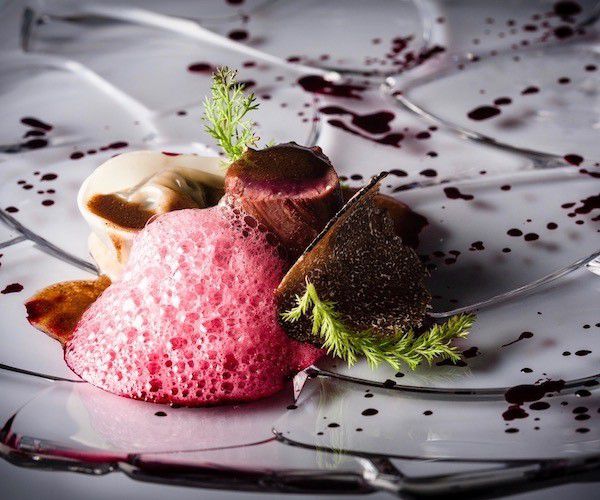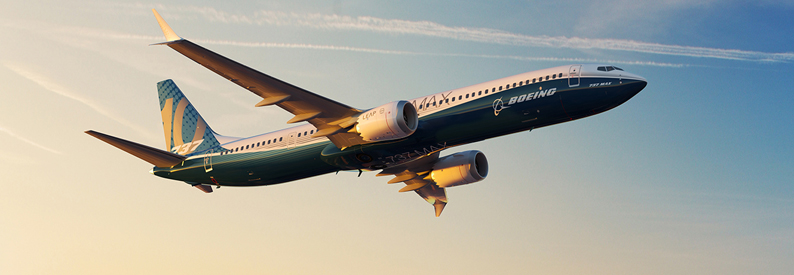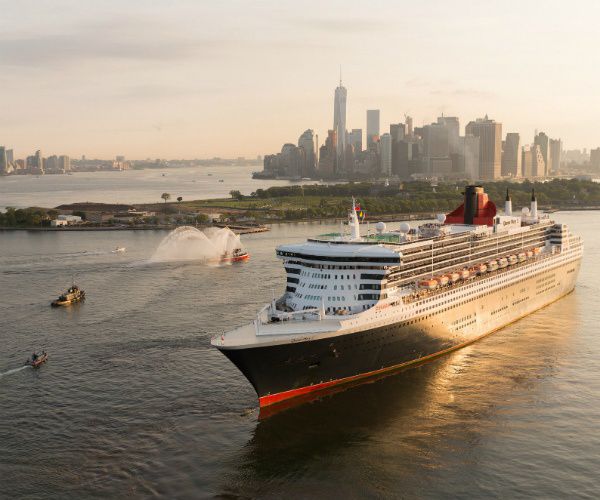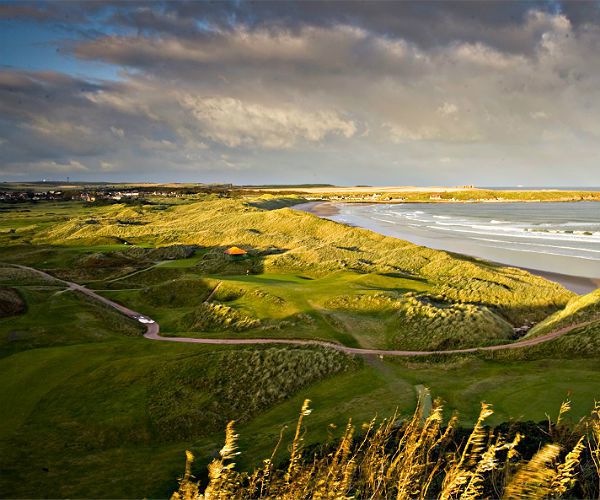The best luxury honeymoon retreats in Australia

From dinner under a canopy of stars to relaxing couples massages, every retreat on this list offers outstanding experiences, spectacular locations and plenty of privacy to make your Australian honeymoon all you dream it could be. Whatever your preference — quiet pampering or outback adventures — these incredible retreats offer something for everyone.
Emirates One&Only Wolgan Valley – Blue Mountains, New South Wales
Secluded and ultra-luxurious, Emirates One&Only Wolgan Valley offers an indulgent escape surrounded by the magnificence of Australia’s Greater Blue Mountains in New South Wales. Each of the 40 gorgeous villas here features spectacular mountain views, providing the perfect backdrop for relaxing on the expansive veranda or in the private heated pool.
After a day of nature and wildlife tours, horseback riding, or biking through Wolgan Valley, you can unwind with therapeutic treatments at the beautiful day spa. Later, you can savor the exquisite offerings of The Wolgan Dining Room or The Country Kitchen, including delicious local meats and cheeses, artisanal bread, and fresh salads.
InterContinental Hayman Island Resort – The Whitsundays, Queensland

InterContinental Hayman Island Resort is a private island retreat in the breathtaking Whitsundays in Queensland, Australia. Here you can revel in luxe island living in one of the luxurious rooms, suites, or villas that all feature panoramic seascapes or garden views. During your stay, you can enjoy a host of romantic activities, from private picnics on a secluded beach to diving along the Great Barrier Reef.
Discover the flavors of Queensland in one of Hayman’s five dining venues. Then transform your mind and body with a healing massage or balancing yoga sessions in the resort’s wellness center. Or spend the afternoon watching the sunset over the famous Whitsunday Islands as you enjoy dinner or a quiet stroll on the beach.
Spicers Sangoma Retreat – Blue Mountains, New South Wales

Make your honeymoon extra special with a stay at Spicers Sangoma Retreat, an all-inclusive destination embraced by the natural beauty of the Blue Mountains in New South Wales. Expect lush bushland and African-themed suites, each designed with its own personality, offering privacy and an intimate escape that couples love.
Relish your holiday together in the infinity pool overlooking the valley, then indulge in a couples massage while you relax to the sound of the nearby waterfall. There is a bar and restaurant on site where you can savor a sophisticated 5-course meal paired with exceptional local wines.
Southern Ocean Lodge – Kangaroo Island, South Australia

Set on the scrub-covered dunes of Kangaroo Island in South Australia, on the edge of a rugged sea cliff, Southern Ocean Lodge puts you in a world of your own. Each day here brings you closer to the honeymoon of your dreams and new wonders to discover, from the infinity-edge plunge pool, destination spa, and wine cellar to the sand and surf of Hanson Bay just a short walk away.
Calming, contemporary interiors and rates that are inclusive of all food & drinks ensure a restful and romantic stay at Southern Ocean Lodge. The 21 luxe suites are intimate and come with bespoke furnishings, a sunken lounge, plush beds, glass-walled ensuites, and a spectacular outdoor terrace that looks out to breathtaking views of the great Southern Ocean.
El Questro Homestead – The Kimberleys, Western Australia

A luxurious all-inclusive retreat on the edge of Chamberlain Gorge in The Kimberleys, El Questro Homestead is the ultimate getaway for couples in Western Australia. The 9 luxurious suites here are designed to flow seamlessly from indoors to outdoors. Each provides arresting views from the wrap-around verandas, a fabulous outdoor bathroom for two and floor-to-ceiling glass windows.
El Questro offers all-inclusive rates and plenty of adventures to engage in with your partner. Explore on foot, by boat, by helicopter, or on horseback. Or take it down a notch and chill out by the pool or savor the exquisite offerings of the Homestead from breakfast on the veranda to dinner under the stars.
Longitude 131° – Red Centre, Northern Territory

Set in Australia’s Red Centre, Longitude 131 features luxury tented cabins with expansive decks and lavish beds, surrounded by the rugged wilderness of the desert, and breathtaking views of Uluru. This safari-style retreat comes with plenty of inclusions and convenient amenities, such as all meals, an open bar, signature experiences, an in-room iPad, free gourmet mini-bar with premium Australian wines, Wi-Fi access, and airport transfers.
Lovebirds should definitely experience the Uluru and Kata Tjuta guided tours included with your stay, then get whisked to a secret location to dine under the stars at Table 131. You can also reserve a private dinner atop a dune or retreat to Spa Kinara for a revitalizing massage. And, of course, you can always soak up the scenery in the pool, with a glass of bubbly in hand.
Lizard Island – Great Barrier Reef, Queensland

Escape to a private island retreat on Australia’s Great Barrier Reef at Lizard Island Resort. Featuring 24 private beaches and 40 villas, this is the perfect sun-drenched getaway for couples on their honeymoon. Experience the magnificence of the Reef together via snorkeling or diving. Dine on the beach, under the stars, or at the Saltwater Restaurant. Better still, pack a gourmet picnic basket and head to one of the private beaches for some quiet time.
Lizard Island’s beautiful villas feature commanding sea views and direct access to the white sandy beach. Plunge pools, large ensuites with tubs, and lavish furnishing are the norm here, as well as superlative service of course. Rates include all meals, daily sunset champagne and canapes, and use of kayaks, paddleboards and snorkeling equipment.
The Louise – Barossa Valley, South Australia

In its idyllic setting among lush vineyards of the Barossa Valley in South Australia, The Louise is a luxury retreat that blends the best of nature, wine, and food. After a day of savoring the best vintages and gourmet offerings from the region, return to the property in time for dinner for two at the award-winning Appellation or a refreshing dip in the infinity-edged pool.
Later, you can retreat to one of only 15 luxury suites that come fitted with all the mod cons and a large ensuite with a spa tub for two. There is a terrace overlooking the vineyards that makes the perfect spot for an evening glass of wine while watching the sunset.
Silky Oaks Lodge – Daintree Rainforest, Queensland

Surrounded by the Daintree Rainforest in far north Queensland is Silky Oaks Lodge, a luxury rainforest retreat that is a favorite with couples. The lodge’s rooms and suites, dressed in natural tones with rich timber floors and furniture, feature hammocks and private verandas which overlook the lush rainforest or the river.
Couples looking for an immersive experience can go on a guided rainforest walk, visit nearby Port Douglas and stroll the quaint streets and shops, or drive along Great Barrier Reef. For something more laid back, you can partake in a yoga session, book a couple’s massage at the spa, or dine amongst the trees at the Treehouse Restaurant.
Cape Lodge – Margaret River, Western Australia

Experience an unforgettable honeymoon at Cape Lodge in Western Australia. This private country house in the renowned Margaret River region features 22 luxurious rooms and a separate 5-bedroom private residence. All are spacious and feature king-sized beds, high vaulted ceilings, spectacular views, and en suite bathrooms for the ultimate in comfort.
Forty acres of lush forest, lake, and gardens surround this secluded luxury lodge. Choose to spend your day on the beach, hiking the forest trails, playing golf, or canoeing on the Margaret River. Alternatively, head straight to the spa in the Main Lodge for a full body massage or facial. Then end the day relishing some French-influenced country fare made from delicious fresh local produce and seafood.
There is no question that Australia offers some incredible options for an unforgettable honeymoon. However, figuring out which one of these amazing properties you’re going to visit on your honeymoon will definitely be the hardest choice yet.
Author Name: Mat Lewis
Tips on how to counter jet lag

This is a safe and effective remedy for countering jet lag, in the form of easy-to-take tablets. Its effectiveness has been proved in a scientific trial of round-the-world passengers and confirmed by longhaul flight attendants in a test conducted in cooperation with their union. Being a homeopathic preparation using extremely low dosages, No-Jet-Lag has no side effects and is compatible with other medications. It has no connection with the controversial hormone melatonin. No-Jet-Lag is available at luggage stores, health stores, pharmacies and international airports, click here for store locator, or click here to order No-Jet-Lag online from Magellan’s. https://www.magellans.com/Default.aspx?ref=err
Pre-flight
This is one of the most important aspects of combating jet lag. Before departing, make sure you have all your affairs, business and personal, in order. Ensure you are not stressed-out with excitement or worry, and not tired or hungover from a function the night before. Get plenty of exercise in the days prior to departure and try to avoid sickness such as the flu, colds and so on. If you have a cold, flying will probably make it worse – ideally you should delay the trip. Get a good night’s sleep just prior to departure.
East or west?
There is much debate about whether it is better to fly eastward or westward. It may be largely a matter of personal preference, but there is some evidence that flying westwards causes less jet lag than flying eastwards.
Night or day flight?
Again it is largely a matter of personal preference based on experience. Most travelers think daytime flights cause less jet lag. We note that more daytime long haul flights are being added by major airlines.
Drinking fluids
The dry air in aircraft causes dehydration. Drinking plenty of non-alcoholic fluids counters this. Water is better than coffee, tea and fruit juices. Alcohol not only is useless in combating dehydration, but has a markedly greater intoxicating effect when drunk in the rarefied atmosphere of an airliner than it does at ground level.
Sleeping aids
Blindfolds, ear plugs, neckrests and blow-up pillows are all useful in helping you get quality sleep while flying. Kick your shoes off to ease pressure on the feet (some airlines provide soft sock-like slippers, and many experienced travelers carry their own).
Exercise
Get as much exercise as you can. Walking up and down the aisle, standing for spells, and doing small twisting and stretching exercises in your seat all help to reduce discomfort, especially swelling of legs and feet. Get off the plane if possible at stopovers, and do some exercises or take a walk. This also helps to reduce the possibility of blood clots and associated trauma.
Showers
During extended stopovers on a longhaul flight, showers are sometimes available. A shower not only freshens you up but gets the muscles and circulation going again and makes you feel much better for the rest of the flight. Trans-Pacific pilots have told us taking a shower in Hawaii helps them recover more quickly from the general effects of jet lag after the flight.
Melatonin
This is a controversial and complex treatment for jet lag involving the manipulation of a hormone in the body, starting in the days preceding travel. Research shows that if you miscalculate the right time to take it, melatonin will actually make jet lag worse! And for research that casts doubt on whether melatonin does counter jet lag click here.
Anti jet lag diet
Another complicated method is the anti jet lag diet. Like melatonin, this is for people with lots of time on their hands who can devote several days before and after a trip to preparing. Although it has some passionate devotees it is complicated and there is little evidence that it works.
Sleeping pills (don’t!)
Some people use sleeping tablets to try to alleviate jet lag. This is a dangerous approach as sleeping pills induce a comatose state with little or no natural body movement, and it is well known that prolonged immobility during flight can lead to fatal blood clots (deep vein thrombosis). This was reported as far back as 1988 in the Lancet, which said it was estimated “that over three years at Heathrow Airport, 18% of the 61 sudden deaths in long distance passengers were caused by clots in the lungs.” Picture the leg veins as bags of blood. When this blood doesn’t circulate there is a risk that it will clot. In addition, many so-called sleeping pills are variants on anti-histamines and they tend to dehydrate significantly, adding to the already significant problem of in-flight dehydration.
Discover the best of Ecuador
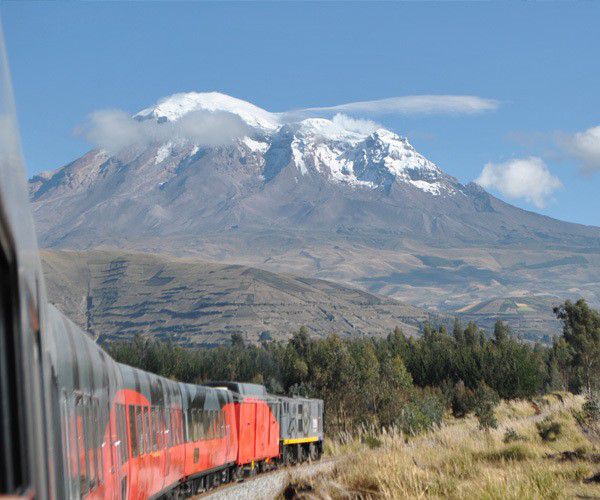
For many luxury tourists, Ecuador travel means only one thing: Galapagos cruises around the islands. While a small ship cruise in the Galapagos Islands is a fantastic tour, the rest of the country deserves more than a quick stopover!
Ecuador is improving its number and quality of luxury travel offerings each year and investing a tremendous amount in infrastructure, including one of South America’s few working train lines. Besides small pampered yacht cruises for a Galapagos vacation, there are now more and more luxury hotels in the Galapagos for those who don’t want to spend a whole week on a ship.
Luxury travel in Ecuador embraces the authentic adventures found within the four regions of the country and the stunning terrain within their borders. Most of the top luxury hotels and lodges are focused in the two largest cities of Quito and Guayaquil or the jungle, though Ecuador probably has the largest concentration of hacienda hotels anywhere in South America. As travelers explore the country on vacation, they will have a memorable stay each night, blogs Marcel Perkins.
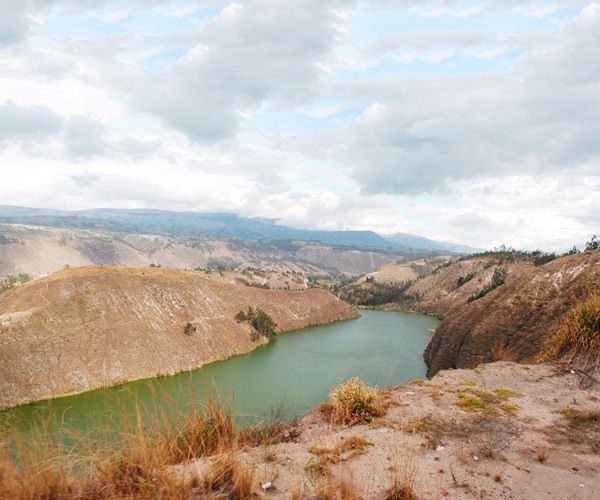
Out of the way retreats beckon to those who want to celebrate the finer things in life, while immersing themselves in the outstanding natural reserves in the cloud forest, the Galapagos Islands, along with the coast, and in the jungle.
What makes luxury travel in Ecuador stand out is the level of commitment that goes into respecting the natural assets in the country. In the jungle, lodges are built using traditional materials, in the Galapagos Islands land-based hotels are involved with conservation and preservation projects, in the cloud forest-hotels are part of large nature reserves where naturalists are part of the staff.

Astonishing wildlife, smoldering volcanoes, picturesque colonial towns and colorful markets are just the start of what Ecuador has to offer. It is the second smallest republic in South America and contains everything an adventurous visitor could wish for, from fascinating towns to explore, to dramatic scenery and biodiversity in the Amazon Basin and highland cloud forest. The cultural highlands of Ecuador are a fantastic mixture of Spanish colonialism and Amerindian influences, best seen in the architecture and markets of places such as Quito, Otavalo and Cuenca. The Galapagos Islands, home to the world’s most fascinating wildlife, helped shape Darwin’s theory on evolution. Here you can come face to face with giant tortoises, catch a glimpse of a blue-footed booby or swim with playful seals and penguins. Taking a cruise is the best way to become intimately acquainted with the very different islands in the archipelago, making shore landings, snorkeling, kayaking or diving by day, and enjoying first rate amenities in the evenings.
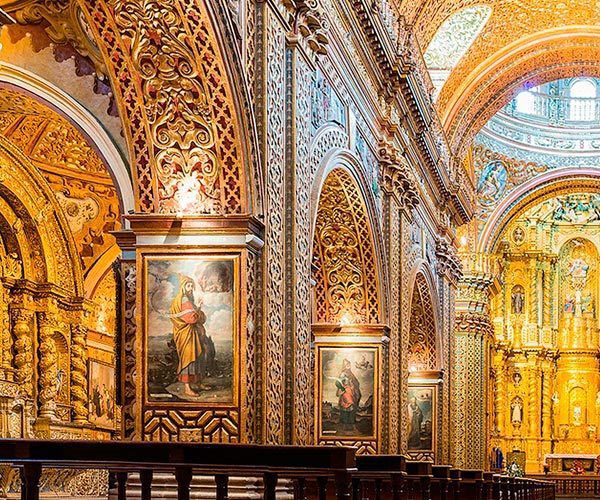
Mainland Ecuador is the home of the Panama hat, impressive Andean peaks, quiet beaches, and a jungle full of diverse wildlife. This country on the Equator is blessed with an impressive variety of natural attractions. Massive mountains and volcanoes attract casual hikers and serious climbers, while the Amazon jungle basin and rainforest of Ecuador attract a different kind of explorer. In much of the country, get a nice mountain view out the window and find one of the highest concentrations of volcanoes in the world.
Quito’s compact Old Town, a UNESCO World Heritage Site, is undoubtedly the place to begin exploring. Climb rickety ladders up the spire of the impressive Basilica del Voto Nacional, marvel at the intricate gold detailing in the San Francisco monastery and settle down to dinner in one of the pleasant, colonial plazas. A striking statue of the Virgin Mary watches over the city from neighboring hill El Panecillo, colorful market stalls spill out onto the cobbled streets and smiling stall holders welcome you in whilst lively bars draw a mixed crowd of locals and travelers, creating an infectious buzz and a city that welcomes you back with open arms after ventures to the Amazon and Galapagos Islands beyond. C cobblestone plazas, ornately decorated churches and neo-gothic buildings sit side by side with glass-fronted restaurants and a thriving nightlife scene in Ecuador’s enchanting capital. Quito’s distinct neighborhoods create a beguiling city of contrasts, where the urban sprawl is hemmed in by sweeping volcanoes and some astonishing hilltops from which to enjoy the views.
Central Highlands
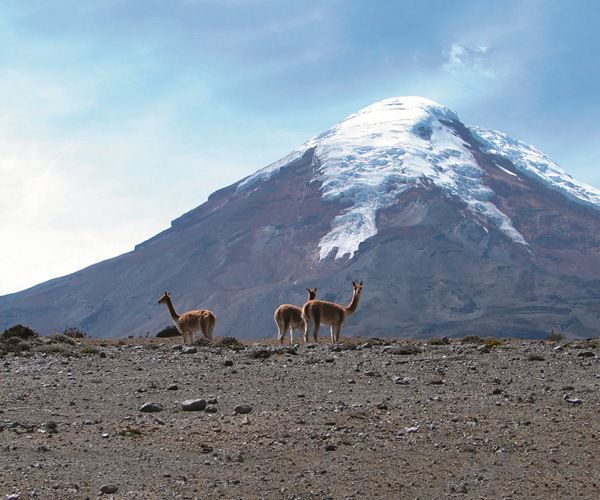
Towering volcanic peaks form a dramatic, snow-capped corridor through the center of Ecuador, an area brimming with Andean tradition and a hub for outdoor excursions. The Avenue of the Volcanoes is synonymous with high octane adventures, whilst traditional haciendas and charming colonial towns dotted throughout provide a welcome and relaxing contrast.
Bustling markets showcase a riot of colorful artesian crafts and folklore abounds, while a patchwork of fields zig-zags its way up the steep inclines as age-old agricultural traditions prevail. Spend your days on horseback or exploring on foot, speed down the slopes of Cotopaxi on a mountain bike, stock up on traditional souvenirs at the famous Otavalo Market or simply enjoy spectacular scenery as you peer into the endless azure waters of the Quilotoa crater lake.
Southern Ecuador
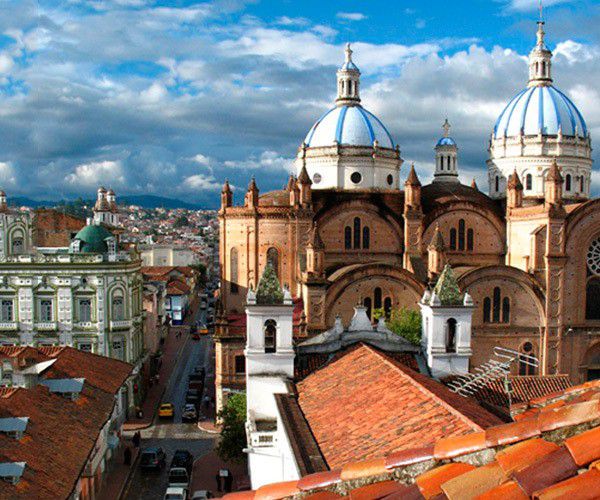
As the drama of Ecuador’s Andean spine ends, lofty volcanoes make way for the misty grasslands and rugged lakes of the paramo. Open plains break up quaint towns and the fertile valleys and lowland forest welcome visitors as though from the pages of a fairy-tale. The chief urban areas here, Guayaquil and Cuenca, form the gateways to more magical climbs from the Galapagos to the Ingapirca ruins.
Hiking trails through this mystical landscape, as well as the fascinating Inca ruins at Ingapirca, can be reached from nearby Cuenca, a pleasant town famed for its colorful flower market and traditional panama hats.
Further west, the vibrant coastal city of Guayaquil forms the gateway to the Galapagos. Having recently undergone a complete revival, Guayaquil’s waterfront malecón makes for a pleasant stroll with its gardens, museums, galleries and shopping centers, and is the beating heart of this bustling metropolis. Colorful barrios rise up on the hillside creating a toy-box like feel and this fun and infectious energy extends right through the city’s parks and plazas to the restaurants and bars which make up its lively nightlife scene.
The Ecuadorian Amazon
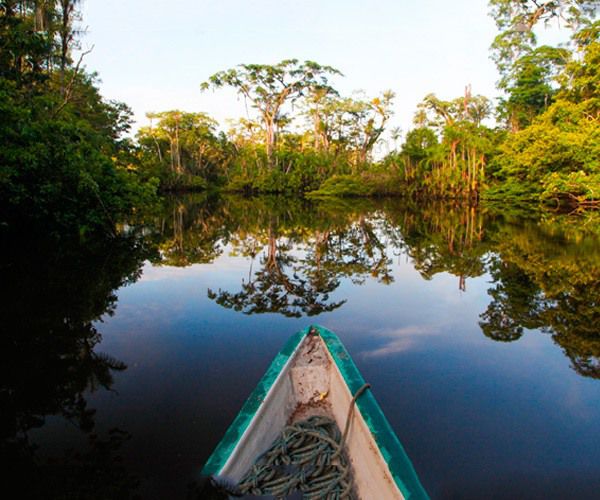
Ecuador’s Amazon rainforest is a rich tapestry of meandering rivers, riotous waterfalls and vibrant flora which overwhelms the senses and offers invigorating adventures to those intrepid enough to venture into its depths. A true wilderness, the Amazon is home to elusive indigenous tribes and all manner of weird and wonderful creatures, offering a completely immersive and educational experience.
Deep within this steamy jungle lie habitats suited to some of Ecuador’s most astounding wildlife; a high concentration of weird and wonderful creatures from giant otters to howler monkeys can be found shrouded in dense vegetation, living in harmony with the indigenous communities that call the Amazon home, such as the Huaorani and Kichwa tribes.
Activities abound within the realms of this pristine wilderness; accompanied by experienced naturalist guides, visitors can enjoy a varied program of wildlife spotting excursions, engage in traditional tribal activities such as blow-pipe hunting, partake in invigorating night safaris or even just laze away some hours swaying gently in a hammock, listening to the enchanting chorus of the rainforest and its inhabitants.
Galapagos
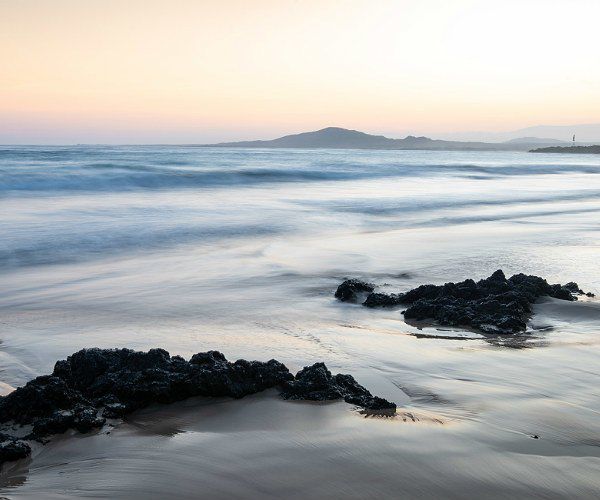
Famous for its unique and fearless wildlife, the Galapagos Islands, just off the coast of Ecuador, are best experienced by cruise. You can swim with sea lions, float eye-to-eye with a penguin, stand next to a blue-footed booby feeding its young, watch a giant tortoise lumbering through a cactus forest and try to dodge the iguanas scurrying over the lava.
The wildlife is truly phenomenal and the scenery, which is barren and volcanic, is hauntingly beautiful. Diving here is thought to be some of the best in the world, but even just by snorkeling or kayaking you will encounter an abundance of endemic wildlife species and come face to face with harmless white-tipped sharks, sea turtles and giant manta rays. Volcanic landscapes provoke explorations on land, reaching crumbling craters and eerie lava fields, mangrove swamps and black sand beaches. Although well geared up to cater to tourists, any visit here will feel as though you are stepping back into a land before time; a truly unforgettable experience.
Wherever travelers choose to visit, the country of Ecuador will cater to the luxury guest with upmarket accommodations, food, activities and culture guaranteeing a great holiday.
Moscow’s 5 most popular street food markets

The savvy luxury traveler knows: luxury isn’t always exclusively defined by price. Sometimes luxury is in the selection that you get to choose from. That is why in Moscow, you should not focus only on glitzy high-end restaurants. The city offers a wide range of brand-new food courts and street food markets that will delight even those with a discerning palate while giving your credit cards a well-deserved break. Here are Moscow’s best choices to eat delicious street food, blogs Ivan Crnogatic.
Central Market (Centralniy Rynok)
The central market on Trubnaya metro station opened as far back as 1840 and became the city’s main food market in the 1960s. Like so many of Moscow’s food courts, it underwent a major rehaul and was reopened in 2017. Nowadays, it’s divided into two zones. On the lower level, you can buy fresh foodstuff while on the ground floor, there are no less than 40 options of street food to choose from. I recommend not missing out on the Belgian waffles that are right at the market’s entrance.
Danilovsky Market (Danilosvkiy Rynok)

This market on Tulskaya metro station was as well reopened in 2017 and follows a similar conception: fresh food and street food in one place combined. There are a couple of excellent choices that you should not miss when visiting this one: café Bo serves delicious and authentic Vietnamese food at minuscule prices. The Dagestani stand at the market will let you try specialties from the Russian Caucasus.
Streat

Unless you’re looking to buy furniture in the megastore above, you might not make your way out of the center to Avtozavodskaya metro station to visit this food court. That would be a shame though because where else are you able to try burgers with Coke syrup like in “Cola Burgers”? If that’s a bit out there for you, go with the Crimean shrimps and seafood or another one of the 38 selections from all around the world to choose from.
Vokrug Sveta (Around the World)

If you prefer to stay a bit more central, you should stop by Vokrug Sveta on Nikolskaya Street just off the Red Square. You will not only find more than two dozen food stands to choose from (my personal recommendation: the Neapolitan pizza) but also a very lively atmosphere with live concerts and upbeat music on the weekends. For those that don’t want to go to a night club but would like to have a drink in a relaxed atmosphere, this is for you.
Depo Moscow

Located on Belorusskaya metro station, this is Moscow’s biggest and most recent addition to the food court scene. There are no less than a mind-boggling 75 stands to choose from so forgive me for not having been able to pick the best one yet! This is also the by far liveliest food market, which resembles a relaxed nightclub on weekends. Everyone that’s trendy and hip in Moscow has been here at least once so make sure you don’t miss it.
Places to experience Brazil’s contemporary art
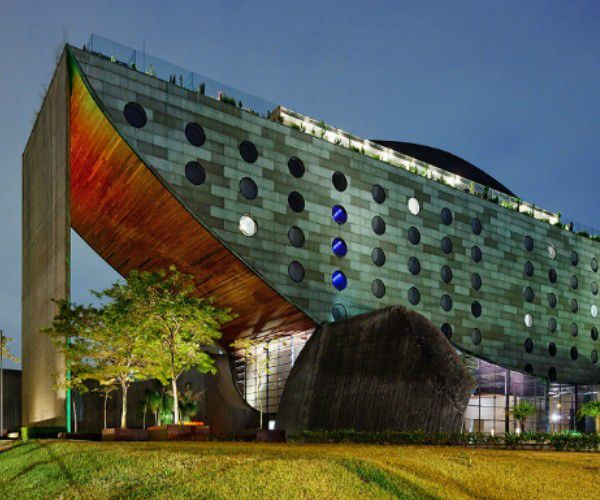
Native American buildings were the original architecture and building blocks of Brazil. More colonial styles became prevalent with the arrival of the Portuguese in the 1500s and these cobbled streets and ornate buildings remain well preserved. However, it was in the 1960s that Brazil entered the ‘big league’ of the world architecture scene with a modernist movement led by Oscar Niemeyer who’s an enduring masterpiece is Brazil’s capital, Brasilia. Niemeyer blazed a trail for other modern architects, landscape designers and contemporary artists to follow. Their work can be found throughout Brazil. Here we round-up for you our ‘must-see’ cities in Brazil for contemporary art and architecture.
Brasilia
Brasília is Brazil’s futuristic federal capital and is the work of architects Oscar Niemeyer, Lúcio Costa, and Joaquim Cardozo, along with landscape architect Roberto Burle Marx, who were united in their vision of simplicity and modernity. Brasília was chosen as a UNESCO World Heritage Site due to its modernist architecture and uniquely artistic urban planning. Highlights for visitors include the Palácio da Alvorada – the official residence of the president of Brazil. Inaugurated in 1958, it is of the first structures built in the republic’s new capital city and gives the impression of being a glass box, softly sitting on the ground with the support of thin external columns. Nearby is the National Congress building designed by Oscar Niemeyer in a modern Brazilian style, with two semi-spheres housing the Senate and the Chamber of Deputies that flank two vertical office towers. The building has been a UNESCO World Heritage Site since 1987. Also worth seeing in Brasilia is the impressive JK Bridge that spans Lake Paranoá, famous for its three 60m tall asymmetrical steel arches that crisscross diagonally.
São Paulo
In São Paulo it’s even possible to sleep in some of the city’s most daring modern architecture. Known locally as ‘the Watermelon’ for its striking crescent shape, Hotel Unique has visually stunning design crafted by Brazilian architect, Ruy Ohtake, who intended the 95-room hotel to look like the curved hull of a ship, complete with porthole windows.
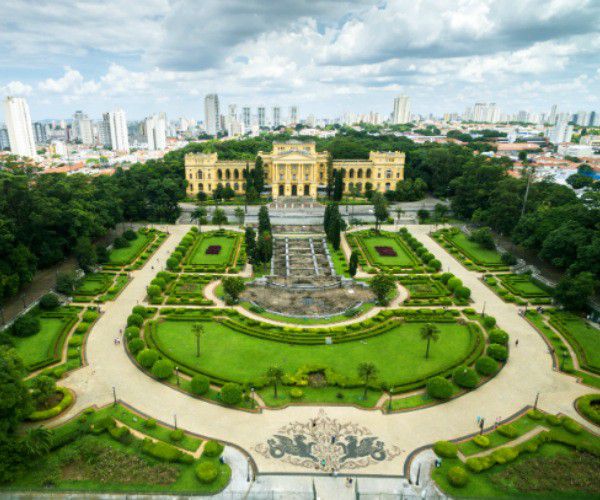
Also in the city next to Burle Marx Park is Palácio Tangará hotel, which has an open-air contemporary art gallery that is free to enter. This summer, the gallery is featuring the work of Brazilian artist and sculptor, Caciporé Torres, winner of three editions of the International Biennial.
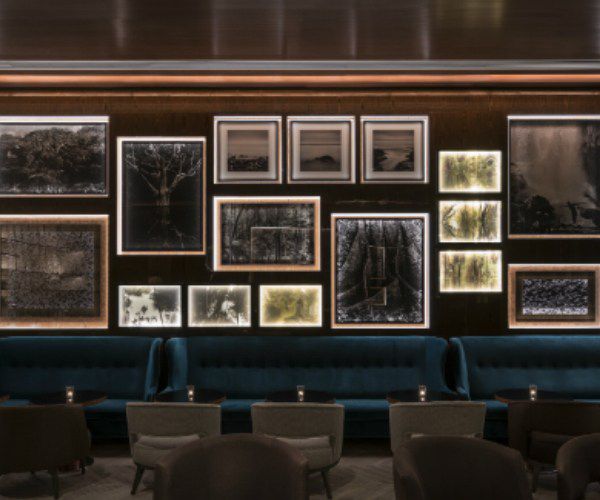
Close by Palácio Tangará is the Museum of Art São Paulo (MASP), which has a collection of iconic artworks by the likes of old world masters such as Goya and El Greco. MASP is notable for its concrete and glass entrance hall designed 1968 by Lina Bo Bardi. Two lateral beams support the main body of the structure over a 74-metre freestanding space. It is considered a landmark of the city and the main symbol of modern Brazilian architecture. Stepping up to the 21st century, São Paulo’s Museum of Image & Sound (MIS) is currently showing a digital exhibit by the Icelandic singer Björk. On display in São Paulo until 18 August 2019, the exhibition Björk Digitalis divided into six areas composed of virtual reality and immersive audio-visual elements illustrating in an interactive way the poetic images of songs by the artist.
Belo Horizonte
When flying into Belo Horizonte, contemporary art lovers should drive straight to the Inhotim Institute 60km away. Nothing quite prepares you for Inhotim and it is often described as Disneyland for art lovers! Inhotim is a beautiful farm in the Atlantic Rainforest, with incredible landscaping by Brazil’s most famous landscape architect, Roberto Burle Marx. It is home to the largest collection of contemporary art in Latin America, with over 20 galleries and pavilions, each dedicated to different artists, both Brazilian and International. The best way to explore the complex is to lose yourself amid the beautiful park and visit the galleries at your own pace over two days. If you are bringing children don’t worry, they will love it to!
Rio de Janeiro
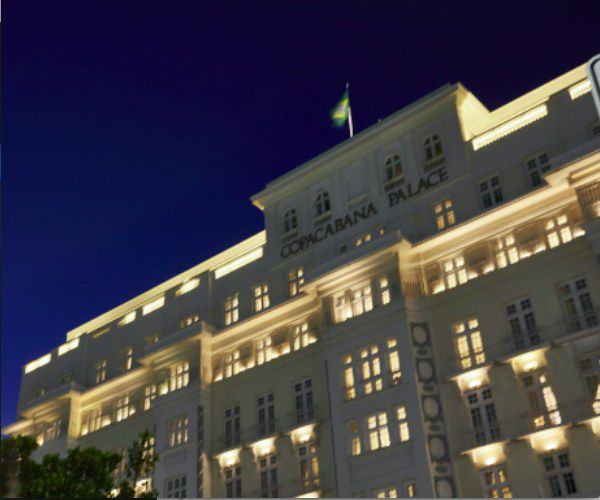
Rio de Janeiro has been inspiring artists and architects for over a century. At the centre is the Art Deco masterpiece, Belmond Copacabana Palace, and having a caipirinha poolside at the ‘Copa’ is still a must do for all visitors to Rio. Commissioned in 1922 to celebrate a century of Brazilian independence, the hotel’s Golden Book overflows with the names of famous faces who’ve visited, from Brigitte Bardot to Justin Bieber; Walt Disney to Diana, Princess of Wales. It was even immortalised in film in Ginger Rogers and Fred Astaire’s 1933 hit, Flying Down to Rio.
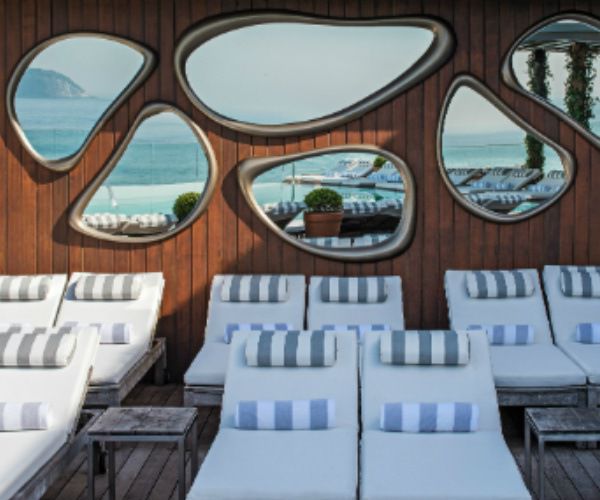
Over on Ipanema Beach, the Fasano Hotel Rio de Janeiro was the first building in Brazil designed by Philippe Starck. It’s architecture and interior design pay homage to the spirit of Brazilian design of the 1950s and 1960s and the glorious Bossa Nova era.
In the heart of Rio’s West Zone is the former residence of the architect and landscape designer, Roberto Burle Marx, which is home to one of the most significant collections of tropical and subtropical plants in the world. The property was designed and built by Burle Marx as a framework for his collection that contains over 3,500 species, replicating Brazilian habitats such as mangroves, sandbanks, and the Atlantic Forest. Visitors can take guided tours to discover the architecture, studio paintings, and personal collections of Burle Marx. There is also the Burle Marx House museum, which preserves 3,125 pieces, including rare objects of art and crafts gathered through his life.
Niterói
When staying in Rio de Janeiro, it’s worth dedicating a day to catching a boat across the Guanabara Bay to Niterói, home to the Museum of Contemporary Art (MAC), another iconic building designed by Oscar Niemeyer and opened in 1996. The MAC dominates the Niterói skyline, set on a cliffside with a 16-meter high, 50-meter diameter saucer-shaped modernist structure, which has been likened to a UFO. In the film Oscar Niemeyer, an architect committed to his century, Niemeyer is seen flying over Rio de Janeiro in a UFO that then lands on the site, suggesting this to be the origin of the museum.
By Simone Scorsato
How to survive the first day of your vacation

If you can answer “yes” to the eternal question, “Are we there yet?” then you probably need a survival manual for the first day of vacation. The 24 hours after you arrive are among the busiest and most stressful — the unpacking and settling in, the arguing, and the inevitable chaos.
It doesn’t have to be. But it took me many, many trips to discover how to make the first day of your vacation as smooth as possible.
I’m not on vacation 300 days a year. But I’m on the road with three teenagers for that amount of time, and we go through many of the same steps that the average family does when they’re away. Arriving at a hotel or vacation rental. Foraging for food. Fighting over what to do with the rest of the first day.
The general problem is nervous energy: Everything’s moving at twice the pace. You’re in unfamiliar surroundings, which heightens your senses. No wonder some people want to turn around and go back home. Hey, it’s stressful.
You know what that’s like, don’t you?
The solution: Plan your arrival time carefully. Hotels, like highways, have rush hours — times of the day when check-in traffic is high. Hint: it’s usually after 3 p.m. I try to aim for the early afternoon, so that even if the room isn’t ready, I can get the hard stuff behind me. Then have the hotel store your luggage, find a good coffee shop, and relax. Let everyone else stand in line.
How about the rest of the chaos? Well, that’s easily dealt with before you arrive. Explain to your kids that hotels like to make extra money by offering overpriced bottled water and other minibar treats. Tell them that the TV remote is coated with germs and that you’d rather sanitize it before use — or better yet, avoid the TV altogether and spend time with your family. After all, isn’t that why you’re on vacation?
Chaos!
Ah, food and travel. I could write an entire book on the subject. Restaurants and hotels want you to eat nothing but comfort food while you’re away. But if you do that, you’ll end your vacation overweight and bankrupt.
You will probably have a food argument shortly after arriving at your destination. To avoid it, plan family meals ahead of time. It’s as easy as saying, “We are having sandwiches for lunch.” My middle son, Iden, is always hopeful that we’ll find our way to that overpriced French restaurant for a five-course meal. Declaring your intentions is a clever way to avoid that predictable argument.
Now what?
If all goes according to plan, part of the first 24 hours of your vacation will be spent, you know, on vacation. That means you and your family can hit the beach, go hiking, or hang out in town — whatever you’re there to do.
Deciding what to do can be a source of conflict.
We do a lot of skiing in my family, but if you arrive at a resort in the early afternoon, do you still hit the slopes? My 14-year-old would always say “yes,” but my other two would prefer to do something else. And they have a valid point. By the time you rent gear, the lifts are about to close.
What is a good idea is renting your gear in the midafternoon, when no one else is at the ski shop, so it’s ready for the next morning.
For beach vacations, the compromise is usually a nice walk along the shoreline after dinner. That assumes, of course, that Dad can finish answering all of the emails that have piled up while we were on the plane.
Again, surviving the first day of vacation means careful planning and then sharing that plan with your party. If you don’t, they’ll all go their separate ways — one will head to the slopes, the other to the pizza joint, and the other to the pool. You’ll wish you’d booked a cruise instead.
The first 24 hours of your vacation doesn’t have to fray your nerves to the point where you need a vacation from your vacation. A little planning and careful communication can avoid the worst of it. For the rest of us travelers, there’s always the spa.
By Christopher Elliott, founder of Elliott Advocacy
Travelers hate robots at airports

Ever seen a robot at an airport? LaGuardia has one. Munich’s is called (wait for it) … Josie Pepper. From Amsterdam to Adelaide, they’re cropping up to help give travelers a more seamless flying experience.
In fact, automation of all sorts is popping up at airports. Automated ticket counters has given way to high tech autonomous security and robots that park cars, an approach that’s being tested in London and France.
Only it turns out travelers may not really want that much automation in their airport experience. That according to a new report from OAG, a leading global travel data provider. OAG surveyed 2000 travelers through its flight tracking app, FlightView, about the effectiveness of efforts to streamline the airport experience. The most surprising finding: Robotics, biometrics, and advanced security measures aren’t winning hearts and minds in the war to make traveling less cumbersome.
By most metrics, travelers prefer human customer service to automation most travel functions. That includes baggage (54 percent human customer service preference), security (55 percent), boarding (64 percent), concierge (83 percent), and in-flight services (80 percent). The only area where most travelers prefer automation, in fact, is ticketing and check-in, which are already well-established in major airports.
Robots that give directions? Forget about it. Only 19 percent of respondents believed they improved the customer experience.
So what explains the sudden shift to automation in airports? Part of it is an appeal to a younger generation of air travelers. Though automation technologies are unpopular on average, millennials prefer automation more than others in every area except security. Compared to 50-year-old travelers, millennials are 30 percent more likely to prefer automated airport concessions and retail and in-flight services.
What to take out of your bag when you arrive and what to leave in

You don’t have to rummage through the internet for long to find helpful packing tips this summer. You know, roll your clothing (don’t fold), carry on your suitcase (don’t check) and, of course, pack light. But this vacation season, maybe you really need a few unpacking tips.
That’s right, I’m talking about what to do once you’re at your destination with all the stuff you brought. Do you unpack or live out of a suitcase? If you remove your clothes and toiletries, where do they go? And where don’t they go?
It turns out there’s an art to unpacking, often overlooked by even the most seasoned travelers.
The three-night rule
Should you use the drawers in your hotel or cruise berth or keep everything in your luggage? Experts seem to agree that the answer depends on how long you’re staying.
“For any stay for three nights or more, I unpack into the drawers,” says Carol Rowland, director of tour operations for Recess 4 Grownups Travel, a tour operator.
Why three days? Storing your clothes in drawers takes effort, but not as much effort as removing the items and repacking them. The issue isn’t necessarily the ritual of folding, rolling and squeezing them into the bag. It’s the multiple sweeps through each drawer to ensure you didn’t leave anything behind.
I usually follow the three-day rule, but not always. Sometimes, the drawers aren’t in a convenient place, or it looks as if they haven’t been cleaned in a while – vacation rental hosts, I’m talking to you – and I’d rather live out of a suitcase.
But there are exceptions
The three-day rule doesn’t apply to everything. If you brought a suit or a formal dress, it goes in the closet right away. And the cube with all of your toiletries – straight to the bathroom, of course. Same thing with the shoes.
“Unpack all wrinkle-prone stuff, toiletries and shoes,” says Heidi Siefkas, a professional speaker and author.
If you’ve brought wrinkle-free travel clothes like a Bluffworks blazer, feel free to leave it in the bag. It’ll look good no matter what you do.
Also, if you’re traveling with kids or your significant other, here’s another piece of advice learned from years of travel: Bring your own toiletries. Every member of your traveling party should pack the basics, including a toothbrush, toothpaste, floss, shampoo and a comb. Some of the fiercest vacation squabbles start with the words, “Who has my brush?”
The plastic-bag trick
The most experienced travelers have one more unpacking strategy, which involves a handful of resealable plastic bags — you know, the kind you use in the kitchen to store food. Beth O’Donnell, the general manager of Thomson Family Adventures, a tour operator dedicated exclusively to family travel, always brings a few Ziplocs.
“They’re ideal for putting dirty diapers in, separating your dirty clothes and putting in wet shoes or bathing suits in,” she says. “If you didn’t pack an extra bag, you could at least sort everything into various piles — dirty clothes, clean clothes, shoes, electronics and put them in the plastic bags.”
Susan Stevens, a retired manager for a nonprofit organization and a veteran traveler, says the baggies can prevent a big mess.
“Once an item is soiled and I can’t get it clean while traveling, I roll it into a plastic bag so it doesn’t contaminate my clean clothes,” she says.
Often, your luggage comes with a laundry bag, which experts recommend you bring along. I have an oversize, bright orange laundry bag with “HAZARDOUS MATERIAL” written on it. Hard to miss something like that when you’re gathering all of your belongings.
All of which brings me to the most challenging part of unpacking: You have to repack, and there’s always a chance you’ll miss something. But that’s a whole different topic.
Even more unpacking tips
Use a packing cube for easy unpacking
Linda Scanlon, a frequent traveler and retired assistant clerk magistrate from Medfield, Massachusetts, says packing cubes are an organized way to store items that don’t hang in the closet. “I just pop the cube out of the suitcase and into the bureau drawer,” she says.
Clean clothes out, dirty clothes in
Another strategy used by veteran travelers is to take out the clean clothes and use the empty bag to return the dirty clothes. “On my last day, everything’s back in my bag — and off I go,” says Carrie Pasquarello, CEO of Global Secure Resources, an international risk mitigation company.
Keep it in plain view
Cepee Tabibian, a social media marketer based in Madrid, always places her unpacked items somewhere visible: on the desk, nightstand, by the TV, “somewhere I’m sure to see them.” But never in a closed drawer. “Otherwise, I’m sure to forget about it,” says Tabibian, a frequent traveler who founded the site She Hit Refresh.
By Christopher Elliott, founder of Elliott Advocacy
How to take a real staycation this summer

Between running a start-up company and wrapping up his graduate degree, Pierre Huguet is too busy to take a vacation this summer. “I don’t have much time to travel around, so I’ve decided to stay home,” he says.
Instead, he’s taking a staycation, a getaway popularized after the Great Recession that’s seeing a resurgence this year. MMGY Global, a travel and hospitality marketing and research company, predicts a slowdown in leisure travel this year, which could translate into more staycations.
Huguet, who lives in Sherbrooke, Quebec, with his girlfriend, says he’ll spend mornings working and the afternoons exploring the area with her. “It’s a beautiful region surrounded by rivers, mountains, lakes — and poutine,” he says.
A staycation usually involves a long weekend or a week in which you participate in leisure activities that don’t require overnight accommodations. But this summer, America’s staycationers are pushing the limits of their grounded getaways.
“They’re looking for authentic, hands-on or interactive learning experiences,” explains Simon Hudson, director of the Center of Economic Excellence in Tourism and Economic Development at the University of South Carolina. Exactly how they plan to achieve that authenticity is hard to articulate. Hudson says themes are big this summer, with staycationers exploring subjects such as farming or wine.
The travel industry’s worst nightmare
Yes, it’s the travel industry’s worst nightmare. But for everyone else, it’s a welcome break from the mind-set of a destination vacation: spend, spend, spend. Turns out the key to a successful staycation is a little planning and a strong sense of purpose.
If you’re thinking of a staycation, make sure it counts for something, experts say. For Hana Pevny, it means exploring the area around Kennebunk, Maine. “It’s not only for myself,” she explains. “I’m new to Southern Maine and wanted to get to know my surroundings. It’s also to be able to better advise my guests on local attractions and mini-trips.”
Pevny is the innkeeper at the Waldo Emerson Inn in Kennebunkport, so her staycation will make her a more informed host, she says.
Where to go for your staycation
For Yasmin Parsloe, who lives in Sarasota, Fla., a staycation is all about the beach. And she happens to live near one of the best beaches in the world. Siesta Key, with its white sand and turquoise water, is just a stone’s throw from her place.
“I know that if I’m nearby, I don’t have to put the in-depth planning and preparation into my trip,” Parsloe says. “There’s no concern about doggy day care or worrying about whether someone has a document they need at the office. It alleviates the pressure of being away for a week or two at a time.”
Parsloe has ulterior motives. She also runs a start-up website called Beach.com, which specializes in beach travel. She figures that her staycation will make her even more of an expert on Sarasota’s beaches.
What to do on your staycation
What do you do on staycation? A lot of people don’t plan, so the answer is, nothing much. That’s a mistake, according to experts. “You have to think outside the box,” says Aditi Shekar, the CEO of Zeta, a finance app for couples. “Know what you want to get out of it. Is this staycation one where you want to relax? Have an adventure? Or do something you’ve never done before? Whatever your preference, decide what you want to get out of the staycation.”
Too often, staycationers just let the vacation happen. That makes it utterly forgettable, if not also a waste of valuable vacation time.
How to plan a staycation
Planning doesn’t have to involve a lot of heavy lifting, says Natalie Conrad, a spokeswoman for Minneapolis Northwest Tourism. If you’re a staycationer in the Twin Cities, you can consult the resources offered by the state tourism organization and local convention and visitors bureaus.
For example, Minneapolis Northwest has a website and a blog dedicated to planning fun day trips or long weekends, with suggested itineraries and posts such as 50 Free Things To Do in Minneapolis Northwest and Beyond. You don’t even need an Internet connection to plan your staycation.
“Pick up the phone and call,” she says. “An old-fashioned conversation with a representative from a state tourism organization or city convention and visitors bureau can help uncover hidden gems you might not have known about in your own hometown.”
I have a perspective on staycations, too. My always-on-the-road lifestyle means I’m at a destination one month at a time, which technically means every day trip is staycation-y. (I just made up that word.) Let me echo Shekar’s advice: If you want to take a staycation this summer, plan it as a vacation. Find out what’s nearby. Maybe select a theme, as South Carolina’s Hudson recommended. And one more thing: Partition work and play.
“While on vacation in a familiar spot, we’re tempted to stay connected to work emails and to-do lists,” Conrad says. “Unplug and be in the moment to truly recharge your batteries.”
By the way, good luck with that. I’m still trying.
By Christopher Elliott, founder of Elliott Advocacy
Discover Chartres, three hours or less from Paris
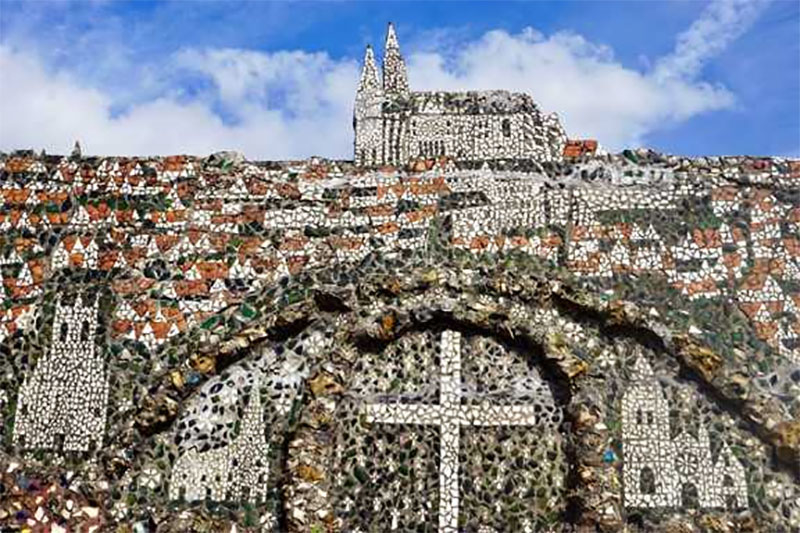
This month we went more local and traveled to Chartres, home of Our Lady of Chartres, of one of the most important and well preserved Gothic cathedrals in Europe. A one-hour train ride from Gare Montparnasse train station, Chartres is in the Loire Valley region on the left bank of the Eure River, near Blou.
A legend among tour guides, Englishman Malcolm Miller has been giving tours of Our Lady of Chartres Cathedral for over 60 years. Aging gracefully with a full head of silver hair and an irresistible British accent, Miller is the foremost expert on the cathedral. In addition to leading daily tours to public and private groups, he also travels worldwide to give lectures at prestigious universities and cultural institutions. A true lifelong scholar, Miller admits that even he doesn’t know all there is to know about the cathedral and still has a thirst for learning, which propels his tours. His daily public tour starts at 12 p.m., and the duration is approximately 90 minutes. His focus on the day we took the tour was on the richly detailed stained glass windows, and he explained in explicit detail their history, meaning and symbolism, along with the general history of the cathedral. The last third of the tour explored the identities of select statues adorning the outside. At the end of the tour, Miller encouraged guests to return the next day or another time because he alternates the information on his tours to various sections of the cathedral on different days. Miller has received two of the highest civilian honors in France, Knight of the National Order of Merit and Knight of the Order of Arts and Letters.
We lunched at a casual bakery café and tearoom, Le Comptoir de Sarah, absorbing all we learned from Miller. All baked goods are made on the premises, paying close attention to gluten free and vegetarian products, such as brownies, scones, cheesecake and cupcakes. Le Comptoir de Sarah also serves sandwiches, soup and salads, and a specialty of the house is a savory scone sandwich served with a side salad.
In the afternoon we visited an off the beaten track attraction that is well known by locals, but not usually listed on Chartres tourist sites. Maison Picassiette, a modest cottage home and garden located on a quiet lane about 10 minutes from the old center of Chartres, is an astonishing combination of an arts and craft home, museum, sculpture garden and chapel, built by hand. Raymond Isidore, a local resident born in 1900, bought a piece of land in 1930 and built a house for his wife and family. A few years later he discovered discarded remnants of glass, ceramics, glass bottles and tin bottle caps in an open field, and perhaps in an unconscious early act of recycling, he started to decorate his house with his findings. It became his obsession over the next 24 years and he devoted a prodigious 29,000 hours, plus 15 tons of found objects, to transform his home. Not only were we amazed by the intricacy and beauty of the mosaics; we also appreciated the painting talents of Isadore with the impressive murals in the chapel and other walls throughout the house. It was a sunny, blustery day, and the sculpture garden was a heavenly delight of spring flowers, including tulips, hydrangeas, and Queen Anne’s lace surrounded by intricate mosaic sculptures, including one of the Eiffel Tower. On a sidewall is a replica of the rose stained glass window of the Chartres Cathedral and another panel with an ancient windmill. Isadore died in 1964, only two years after he completed his home, and in 1983 it was declared an historic monument, which is now owned by the city of Chartres.

Nighttime is the right time in Chartres from April to October, when the mesmerizing and all-encompassing Chartres en Lumieres light show runs. Now in its 15th year, Chartres en Lumieres is a major tourist attraction, with over a million visitors a year, an economic boon to the small town. Capitalizing on the draw of the cathedral, Our Lady of Chartres is the starting point of a dazzling and stunning display of light, color and pattern. There are 23 illuminations across the town center projected on buildings, public plazas, bridges and other churches, and each are clearly marked on a special map, along with blue sensor lights embedded in the streets when one is close to one of the illuminations. Stretching over a 5-kilometer radius, we opted to take a slow tram to see the illuminations, and also to learn the history of the rest of the city. The tram stopped at almost all the illuminations, leaving us enough time to photograph and take videos.
Since Chartres en Lumieres didn’t start until 9:45 p.m., we enjoyed a leisurely dinner at Brasserie la Cour in The Grand Monarque Hotel. Located in the airy courtyard enclosed in glass, we took in the relaxing setting while sipping on a fine glass of Chinon 2015. The duck burger with foie gras with an exotic black bun made of black curry and vegetables, was sensational, followed by a le Rubis, a formidable dessert made of red seasonal berries and a thick layer of vanilla mousse. The four-star hotel has a spa and a one-star Michelin restaurant, Le Georges.
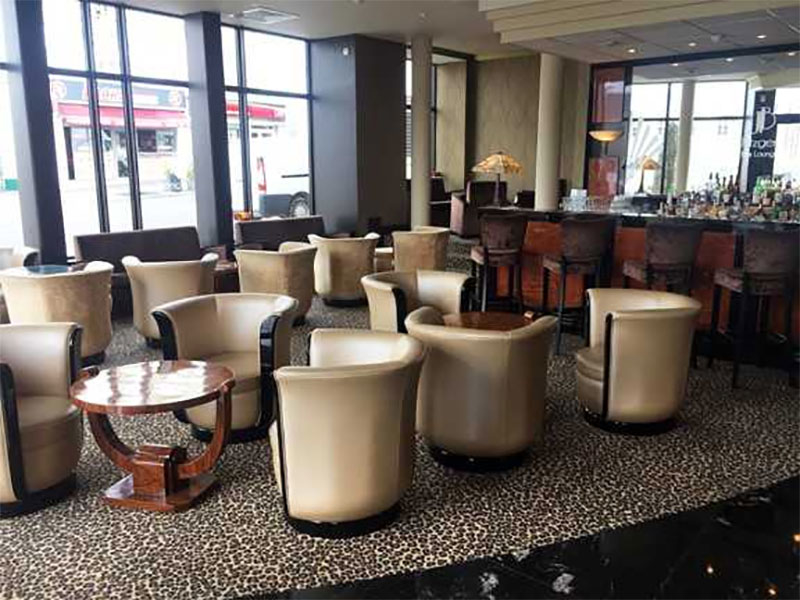
Originally constructed in 1930 as an Art Deco hotel, Jehan de Beauce was refurbished in 2014. Feeling like a 1930s nightclub from a Fred Astaire film set, the elegant lobby bar was decorated with Champagne colored leather club chairs, handsome, round cocktail tables and leopard patterned carpet. Our inviting, well appointed room had plush, white terry robes and slippers at the foot of the king-sized bed, a velvet couch, and Art Deco-inspired carpeting in a pattern of bold black circles against a beige background. Jehan de Beauce has 35 rooms, a spa, fitness room and sauna, and also Swedish, California and Ayurvedic massages. Every Wednesday night the lobby bar Le Fitzgerald presents a tribute to the great Ella Fitzgerald with a musical trio.
Although Chartres is a great day trip, we highly recommend staying overnight to see the illumination show if you are visiting between now and October 13.
Malcolm Miller Tours of Notre Dame de Chartres
Daily at 12 p.m. except Sunday; meet in front of the gift shop of the cathedral
Tel: +33 (0)2 37 28 15 58 Email: millerchartres@aol.com
Le Comptoir de Sarah
6 Place Billard, 28000
Open Tuesday 2 p.m.-6 p.m., Wednesday to Sunday, 11 a.m.-6 p.m., closed Sunday
Picassiette
22 rue du Repos, 28000
Open Monday, Wednesday, Thursday, Friday, and Saturday 10 a.m.-12:30 p.m., Sunday 2 p.m.-5 p.m., closed Tuesday
Hotel Grand Monarque
22 Place des Épars, 28000 Tel: +33 (0) 2 37 18 15 15
http://www.bw-grand-monarque.com/en/
Hotel Jehan de Beauce
1 Place de Semard, 28000 Tel: +33 (0) 2 37 21 01 41
http://www.jehandebeauce.fr/
Chartres en Lumiere
Until October 13; every evening starting at nightfall
https://www.chartresenlumieres.com/en/
Hip and cosmopolitan Hong Kong

Cool and cosmopolitan (social media posts have a way of capturing this pretty well), Hong Kong is so much more than just a concrete skyline and a great city to visit with friends.
The former British colony is 70% greenery including mountains and countryside, surrounded by water and offers multiple forms of transit that double as diversions. Ferries, trains, taxis, double-decker buses, air trams and walking escalator commutes—you name it, Hong Kong will take you where you need to go, in whichever mode of transportation is suitable for you.
Lucky for me, my BFF moved to Hong Kong a year or so ago and while exploring is in my nature, it was nice to have an itinerary at times, provided by a (now local) expatriate and also being able to wander off on my own.
The fourth-most densely populated region in the world, Hong Kong is teeming with culture.
The city has lots of traditional Chinese street food and fancy dim sum options, but also a great international mix of cuisine like French-Vietnamese, Japanese and Spanish-inspired tapas spots. Same goes for nightlife: there’s karaoke and rooftops with city views, bougie hotel bars, salsa clubs (with super-skilled local salsa dancers!) and tiki bars.
The possibilities are endless, but don’t expect to walk less than six miles a day here.
Stay/Sleep
With rooms starting at around $130 USD a night, a stay at Tuve won’t leave you broke (unlike other lovely Hong Kong hotels, where comfort mostly comes with a hefty price tag).
This boutique hotel is hidden on a bustling street in the residential Causeway Bay neighborhood and its minimalistic Scandinavian design will give you a serious desire to redecorate your own place in floor-to-ceiling white marble with hints of concrete and oxidized metal. Tuve’s robes and slippers are plush and in the intense tropical Hong Kong heat, you may not want to leave your cool, cozy room with big windows, blackout curtains and Le Labo Santal 33 bath products.
Eat/Drink
Think good paella in China doesn’t exist? Well, it does—believe it.
Think good paella in China doesn’t exist? Well, believe it. A fun concept by Michelin-starred chef Jason Atherton, 22 Ships gives off anything but stuffy Michelin-starred vibes. The Spanish tapas-style bar on Ship Street in Hong Kong’s Wanchai area plays a great mix of music, keeps the wine flowing and has the friendliest staff in town. Do not leave without ordering the jamon, manchego and truffle toast topped with quail eggs, the cauliflower dish and the seafood paella with fava beans and crispy bacon.
Desserts are also 100 percent worth it (I die for the goat’s cheese ice cream with granola and raspberries), but try not to get too full because right across the street you’ll find Ham & Sherry and Back Bar, two more lively dining/drinking spots, also by Chef Atherton. I could’ve eaten on this block every night, but alas, there were too many things to do, see and eat in HK — which isn’t a bad problem to have.
Did somebody say dim sum? If you can’t make it to Duddell’s weekend dim sum brunch (it’s recommended you eat on the terrace and wash the dumplings down with a bottle of champagne, or two), lunch hour in the upstairs lounge is just as wonderful.
The entire place (which is a Michelin-starred authentic Cantonese joint, BTW) is a feast for the eyes—not to mention the mouth—with classic and contemporary artworks lining the walls and a small gallery at the restaurant’s entrance. I recommend a cocktail called A Lotus Blossoms; with KiNo Tea gin, yuzu, raw honey, lemongrass, whites, bee pollen and sansho dust, it’s as carefully and beautifully decorated as it is delicious.
Do the honey glazed barbecued Iberico pork as a starter and try all the dumplings, but especially the pork and shrimp dumpling with black truffle. Save room for egg white fried rice and dessert. You could easily spend hours here drooling over the menu and decor.
The cool thing—or one of the many cool things—about Hong Kong is that it’s easy to change scenery, and fast.
A quick taxi ride into Repulse Bay, in the Southern part of Hong Kong Island, will take you to the beach and a small dining/shopping strip with water views. South American, Caribbean and Hawaiian-influenced food in the tropically-decorated Limewood is my idea of comfort food (I grew up eating South American and Caribbean foods in South Florida) and here, there’s plenty to go around. It’s also a great place to take a break from heavy foods by choosing lighter menu items like the Norwegian Salmon Tartare with coconut water and ginger, soft shell crab salad and whole roasted free-range Jerk chicken with caramelized pineapple and mango habanero sauce.
Finish your meal with hand-piped churros and walk it off on a tour of Tin Hau Temple. When you’re ready, hop on a double-decker bus (make sure to sit up top for crazy blue and green views) that’ll take you back to the action-packed city center.
Shop
There is so much to see and buy, if your wallet and itinerary allows, of course. My favorite shops in the city: Buly 1803 (a jaw-droppingly gorgeous and expensive perfumery; I wanted everything here, but settled for a pack of scented matches), Goods of Desire (a lifestyle shop that’s been around since 1996, G.O.D. is a great place to buy souvenirs, including the hilarious and fun Angry Cat by artist Lao Ganbu) and Sake Central (this sake store sells sake, of course, but also Japanese glassware, ceramics, and has a sake bar with snacks by Chef Lok Yan Li) are great places to start.
Fun things to do in Panama beyond the Canal
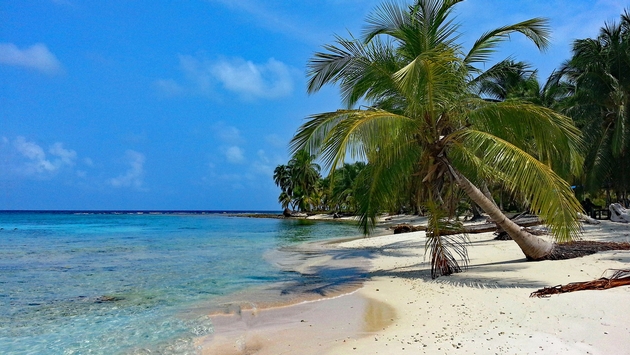
Panama’s most famous attraction may be its legendary canal, but to truly experience this destination in a meaningful way there are a number of other compelling, must-see stops.
Casco Viejo is among the most colorful urban experiences to be had. A UNESCO Heritage site, Casco Viejo is Panama City’s old quarter, a place where buildings date back to the late 1600s.
Searching for untouched nature and culture? Panama’s San Blas Islands offer all of that and more. The archipelago of approximately 365 islands and cays are spread over an area of about 100 square miles. Only about 49 of the islands are inhabited, home to the native Kunas, a gentle group of people who work hard to protect the islands from massive tourism and to keep them healthy and beautiful.
The most common way to explore the San Blas area is by sailing from one island to the next. However, it’s also possible to book flights from Panama City to various local airports.
Yet another notable option when visiting Panama is Gatun Lake. While technically part of the Panama Canal, the lake is an intriguing attraction in its own right. Located to the south of Colon, in the beautiful valley of the Chagres River, this large, artificial lake was created between 1907 and 1913 by the building of the Gatun Dam. Today, you can explore the lake by boat and still skim your hands across the top of the submerged forest of trees. (At the time it was created, Gatun was the largest man-made lake and dam in the world.)
A variety of local operators offer Gatun Lake tours designed to showcase the surrounding flora and fauna and allow participants to get up close to friendly capuchins and howling monkeys that call the rainforest around the lake home. The trips also provide an excellent opportunity to observe numerous colorful, rare local bird species, so bring your binoculars and a good camera.
For hiking fans, Panama’s Soberania National Park is an ideal option. Not only is it one of the country’s finest birding locations, its 55,000 acres protect a bounty of important local animal species including 525 species of birds, 105 types of mammals, 80 different reptiles and 55 species of amphibians. Just a short drive (about 45 minutes depending on traffic) from Panama City, Soberania National Park is the country’s most easily accessible swath of rainforest.
And one last stop, this one for museum lovers, Panama City’s Biomuseo is designed to showcase the country’s natural history. Backed by the prestigious Smithsonian Tropical Research Institute, the exhibits cover Panama’s waters, forests and other natural resources. There are eight galleries at the museum and a biodiversity park that is a living extension of the main building.
What’s more, the unique and colorful museum was designed by famed architect Frank Gehry, making the structure itself worth the visit.
Information about all the possibilities in Panama can be found on the Visit Panama website.
An Outdoor Adventure in Yellowknife
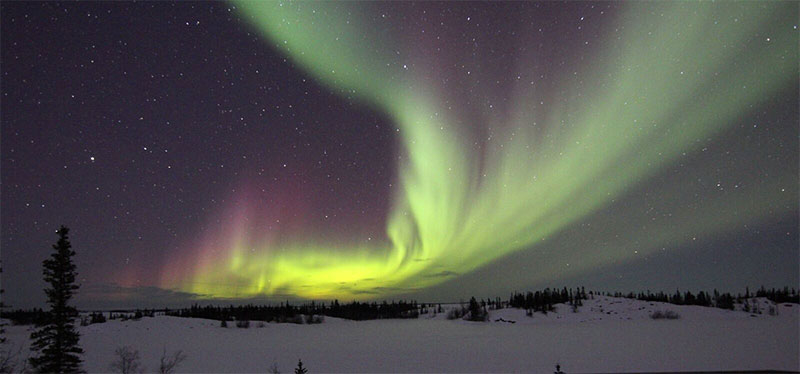
It’s been a while since I’d taken a trip outside of my comfort zone. Perhaps that’s why the chance to see the northern lights in Yellowknife, Northwest Territories in mid-March (think temps of -10° F for a high – pretty frigid for a Florida girl like me!) appealed to my sense of adventure. Also into play was a birthday present for my husband, who was celebrating a milestone year and the worthwhile support of the Ensemble Travel Group – Make-A-Wish live auction and raffle that raised more than $350,000 at last year’s conference in Dallas. Clearly it was a winning holiday all around, and one that’s well suited for your clients who seek the road less traveled. Here’s a first-hand look at my recent experience:
The trip was sponsored by Northwest Territories Tourism and Touch the Arctic Tours, the latter being Ensemble’s On Location partner for this Canadian adventure destination. Air sponsors Delta provided the domestic air travel and Canadian North Airlines flew us from Edmonton to Yellowknife. From Orlando we overnighted at the Renaissance Edmonton Airport, and I’m so glad we did. I don’t think you can get any more convenient than this AAA Four-Diamond hotel that’s directly connected to the airport on the arrivals level, just steps away from the ticket counters and security. In addition, the property’s attention to detail in both décor and dining was greatly appreciated as well.

The Yellowknife Airport (YZF) is a small, efficient operation located less than a 10-minute drive from our hotel and the city center. (Good to know: There is no jetway, so your clients should be dressed accordingly in the winter months when deplaning. While it was a short walk for us, I was caught off guard and quickly got a taste of what was ahead, temperature-wise.)
Our hotel for the next four nights was at The Explorer, a comfortable three-star property currently undergoing an expansion that will add a new 72-room wing, plus an upgrade to existing guestrooms and other areas. Construction should be completed by late fall, although the current building activity did not disrupt our stay at all. High marks go to the hotel and restaurant staff for their eagerness to please and their pride in their community.
I mention pride because it was a thread woven throughout our entire stay in Yellowknife. It’s why our local city tour with Mike and aboriginal tour with Guy and his son Rainer, members of the Yellowknives Dene First Nation, lasted more than three hours, far beyond the original itinerary as they all shared tales of local lore. It’s why Greg, our ice fishing host (and yes, I did reel in a 4 pound pike!), a former big-city accountant turned adventure guide, has called Yellowknife home for 45 years. And it’s what Ensemble member Susan Mercredi, owner of Top of the World Travel and Touch the Arctic Tours, shared when we chatted with her, learning about how this community works together – and not just the great tourism folks – to make visitors feel welcome.
And what about the aurora viewing during our stay? Wasn’t that the main reason for our visit? Well, to call the Northern Lights experience “incredible,” “breath-taking,” and just plain “wow” would not do them justice. Our package included two nights of viewing – one at Aurora Village with about 200 other guests and a second outing with just five of us in a private log cabin. While we had our fingers crossed we’d see the lights, nothing is guaranteed in this type of outing. (Another good to know: Yellowknife averages 90 to 100 percent Aurora viewing success – along with Iceland, Greenland and Norway – due to their location in a magnetic halo. The best viewing months in Yellowknife are September through April, with peak periods in December and March.) We saw the lights both nights, yet enjoyed totally unique displays of colors, frequency and movement each night. It’s a must to see them in different venues, and kudos to Tannis from Touch the Arctic Tours for making that happen. She also arranged for our special winter clothing attire, which became our second skin in order to survive the elements. It’s an absolute must for your clients visiting during the colder months.

While Yellowknife is a year-round vacation destination and a perfect venue for your fishing, hiking, and water sports clients during the summer, the March timing was perfect for us, as we also got to experience the ice road, dog sledding and the popular month-long Snowking Festival. At the heart of this winter wonderland is a huge castle made entirely of snow and ice. It takes the volunteers two months to build the creation. On any given day, the Snowcastle might host a children’s play, followed by an arts exhibit or a rock band, a film festival and finish the night off by transforming into a dance club, making it a great option for your multi-generational clients. Our visit happened to coincide with the annual Long John Jamboree that’s located adjacent to the festival and home to an ice carving competition that draws artists from around the world. It’s truly another wow experience.
We’re back home now in warm and sunny (and humid) Orlando. And, while I feel a bit lighter without my Canada Goose parka and other heavy duty clothing, every so often, come evening, I look up and relive the memories of those shimmering, dancing bursts of brilliant greens and yellows and purples in the night sky. Until next time, Yellowknife…
Alaska Airlines’ JFK lounge with ‘West Coast vibe’
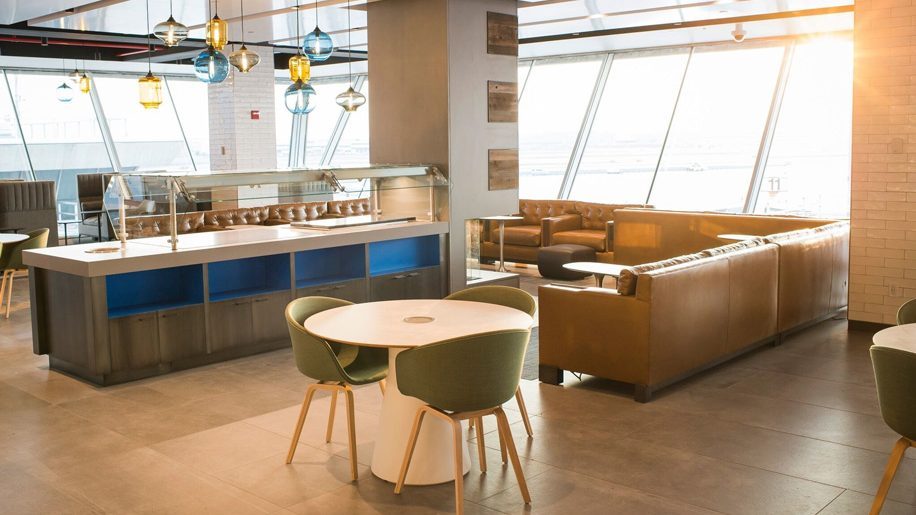
The new Alaska Lounge at New York’s JFK airport is Alaska Airlines’ first lounge on the East Coast of the US, but has more than a hint of the Seattle-based airline’s West Coast origins.
Designed to approximate the casual comfort of a living room, the lounge is staffed by Starbucks-trained baristas, and the food menu includes a selection of West Coast wine and beer as well as healthy choices like oatmeal and yogurt in the morning and soup and salad at lunch and dinner.
“We’re always looking to create warm, welcoming experiences for our guests,” said Brett Catlin, managing director of guest products at Alaska Airlines, who said the JFK lounge “reflects the future of our lounge offering.”
The lounge, available free to First Class passengers, Alaska Lounge members, and anyone else travelling on the airline who purchases a day pass for $45, is located on the mezzanine of JFK’s Terminal 7.
Annual memberships include access to Alaska’s other lounges in Anchorage, Los Angeles, Portland, Oregon, and Seattle, as well as approximately 90 others worldwide.
Alaska Airlines currently operates 14 daily flights from JFK, including recently announced service to San Jose, California.
Michelin star restaurants in Andalusia

With much anticipation and fanfare, the Michelin Guide announces its updated list with what is widely considered the authoritative voice on the world’s best restaurants. With ideal growing conditions and plentiful produce, Michelin stars in Andalusia have been ascendant over the past decade as the gastronomy of the region gains more and more clout and world renown. It’s no coincidence that a majority of these restaurants sit near the Mediterranean Sea, where the bounty is even greater than that by land, and many of them have earned their fame with a focus on the specialties therein.
Andalusia now boasts an impressive 22 stars in all. That’s twice as many as the region was awarded only four years ago, and the province of Malaga is leading the charge with a new total of 10 stars, including Spain’s only newly awarded three star accolade, the highest awarded, to Dani Garcia in Marbella. Angel Leon earned Andalusia’s first three star award just last year with his restaurant Aponiente in Cadiz. He has a second establishment nearby that also earned a star last year, making him Andalusia’s most lauded chef.

Angel Pardo, head of External Relations for the Michelin Guide, put it simply: “Andalucía is growing a lot.” And while Angel Leon, with his four stars combined, has reason to boast, he summed up the increased star count by humbly adding, “Andalucía is fashionable.” The 22 Michelin stars in Andalusia are spread across 18 different restaurants. Here you find a round up of all of them by region.
Malaga
Dani Garcia ***, Chef Dani Garcia, Marbella
Dani Garcia stole the show this year as the only Spanish chef awarded a new third star, joining the ranks of the most excellent chefs world-wide. Garcia carries on in the molecular tradition of fellow Spaniards Arzak and Adria with an evolving approach that is distinctly Mediterranean. More than a meal, a visit to Restaurante Dani Garcia is an engaging and dramatic experience.
Skina *, Chef Marcos Granada, Marbella
Located in the historic heart of Marbella, Skina has the distinction of being the smallest restaurant in the world to hold a Michelin star, seating just 14 diners. Two head chefs collaborate to highlight traditional Andalusian influences with a modern, creative flair.

Messina *, Chef Mauricio Giovanni, Marbella
Opened in 2003, Messina earned its Michelin star in 2016 and has renewed the honour every year since. The menu is constantly changing and relies heavily on the fish and seafood from the nearby Mediterranean Sea. Chef Giovanni delights diners and critics alike with obvious technique displayed in simple, elegant presentations. Here you find no pretense, just skillfully prepared and delicious food.
El Lago *, Chef Juan Jose Carmona, Marbella
Another long lasting mainstay of the prominent Marbella dining scene, El Lago earned its first star in 2005. The cuisine here is ever evolving, and such is the commitment to development that the restaurant exhibits a weeklong presentation of the latest trends in gastronomy once each year, with rotating daily menus.
Jose Carlos Garcia *, Chef Jose Carlos Garcia, Malaga
Malaga native Jose Carlos Garcia proudly bears the mantle of Malaga city’s finest restaurant. Delicate flavours mix with the freshest of ingredients and every plate is as pretty as a picture. Set in the Muelle Uno area of the Port of Malaga, the restaurant overlooks the harbour and lends the sophistication that this cosmopolitan city deserves.

Sollo *, Chef Diego Gallegos, Fuengirola
Chef Gallegos, born in Brazil, brings elements of South American cuisine to the table and touches of Asian fusion. He’s best known as “the caviar chef” for his reliance on locally sourced caviar and sturgeon from the world’s first sustainable, organic caviar farm in Granada province. He uses only sustainably farmed fresh water fish on his menu and offers a welcoming and casual approach to dining.
Kabuki Raw *, Chef Luis Olarra, Casares
In recent years, Japanese cuisine and fusion have become an integral part of the new Malagueñan kitchen. Kabuki Raw has emerged as the finest example of more orthodox Japanese cooking, with a Mediterranean influence. Only the finest raw materials make it to the table, and an onsite vegetable garden provides the accompanying organic produce.

Restaurante Bardal *, Chef Benito Gomez, Ronda
The scenic town of Ronda had not displayed a Michelin star since Dani Garcia left Tragabuches in 2004. That changed when Chef Benito Gomez, originally from Barcelona, came to town. After opening in summer of 2016, Bardal gained its star after little more than a year in business. Ronda is a major wine producer within the province of Malaga and Bardal proudly serves many of the best to compliment two extensive tasting menus of 16 and 20 courses. Chef Gomez doesn’t like to be pigeonholed, saying his style of cooking has no label.
Cadiz
Aponiente ***, Chef Angel Leon, Cadiz
Since earning his first Michelin star in 2010, Angel Leon’s reputation has grown from strength to strength. He earned a second star at Aponiente in 2015, and became the first three Michelin star chef ever in Andalusia in 2018. Known as “the seafood chef,” Leon avoids the obvious choices from the sea making delicacies out of lesser known and less fashionable fruits of the sea. His creative use of plankton, for example, has begun to catch on and can now be sourced in specialty shops along the coast.

Alevante *, Chef Angel Leon, Cadiz
As if his three stars with Aponiente were not enough, Chef Angel Leon operates a second restaurant in Cadiz that also boasts a star. The dishes here reflect the themes and successes of his flagship restaurant, Aponiente, but is a bit more accessible and casual. Located in the only five star hotel of Cadiz, El Puerto de Santa Maria on the beach just south of the city of Cadiz, a meal here is a unique experience easily turned into a daylong outing.

Jerez
LU Cocina y Alma *, Chef Juanlu Fernandez, Jerez (new to the list)
One of two Andalusian restaurants debuting on the Michelin list this year, LU Cocina y Alma only opened one year earlier and immediately created a buzz for its creative approach. Employing classic French techniques with a Spanish flair, Chef Fernandez dazzles with a multi-sensory and fantastical theme relating to Alice in Wonderland. It’s a dreamlike experience on the plate as well as in the dining room.
Jaen
Baga *, Chef Pedro Sanchez, Jaen (new to the list)
The other of the new new entrants to the Michelin star club this year, Baga is an intimate and meticulously run restaurant and the first establishment in Jaen to ever earn a Michelin star. The 15 course tasting menu changes by the season, relying on the produce and products of the time, with a contemporary Mediterranean palate.
Cordoba
Choco *, Chef Kisko Garcia, Cordoba
Born in 1978, Chef Kisko Garcia is one of the youngest chefs of the “new Andalusian cuisine” movement. Based in Cordoba, he draws on local classics and adds touches reminiscent of the city’s Moorish past. Tradition blends with modernity and the simplicity of pure products contrasts with the complexity of refined techniques.
Noor *, Chef Paco Morales, Cordoba
Chef Paco Morales has an impressive résumé, having worked at such famed restaurants as Mugaritz and El Buli before opening Noor to high expectations and fanfare. He has not disappointed. Noor revives the forgotten gastronomic heritage of Al-Andaluz, focusing heavily on the era of Moorish rule from the 10th century, incorporating earlier influences, and delivering diners through centuries of Andalusian culinary development. It’s an exciting approach aiming to rediscover and reinvent ancient recipes, ingredients and techniques in what Chef Morales himself calls a “cultural project”.

Sevilla
Abantal *, Chef Julio Fernandez, Sevilla
The well established Abantal has held its star for more than a decade now. The attention to detail is as evident in the sleek presentation of the dining room as it is on every beautifully presented plate. Steeped in its Andalusian roots, the cuisine draws on Moorish-Arab influences fused with imaginative and adventurous modernity.
Huelva
Acanthum *, Chef Xanty Elias, Huelva
Chef Xanty Elias, a native to Huelva, brought to the city and the wider province its first Michelin star after having trained for two years at the three-starred Arzak restaurant in San Sebastian. Two different tasting menus, changing every six months, continue to excite guests with an ever evolving and often thematic approach.
Almeria
La Costa *, Chef Jose Alvarez, El Ejido
In operation since the 1960’s, La Costa lends history and tradition to the haute cuisine of Almeria. It wasn’t until 2006 that the establishment finally earned a Michelin star under Chef Alvarez, whose innovation and modern touch built on the longstanding success of the restaurant. With three separate dining rooms, the restaurant offers tapas in the tavern, an informal dining room for gourmet gastronomy, and a tasting room where guests can sample the specialties of the chef.
Alejandro *, Chef Alejandro Sanchez, Almeria
Alejandro professes to believe in simple cooking based on respect for traditional Almerían ingredients. To see the sophistication of his creations, you might not call it simple yourself… There is no question as to the purity of the ingredients, often taking on the elegance of Japanese cuisine, particularly evident in his passion for local fish and seafood.
By Alan Hazel from www.carligto.es
Air Canada opens its new premium lounge at Toronto Pearson International Airport
Air Canada has opened a new premium lounge at Toronto Pearson International Airport designed specifically for travellers transiting between Toronto and US destinations.
Located in the Terminal 1 transborder departure area, the new Maple Leaf Lounge Express is open to business class passengers, travellers with Air Canada Altitude status, and Star Alliance Gold members travelling on Air Canada or United Airlines flights.
The 50-seat lounge joins the airport’s three existing Maple Leaf Lounges and features a self-serve bar, light snacks, and complementary wifi. The lounge serves passengers waiting for departures of narrowbody flights to the US.
The ultimate holidays for a celebration

From big birthdays to wedding anniversaries and honeymoons, there’s no better way to celebrate a milestone than with an extra-special getaway. Here, we’ve put together our ultimate list of luxury holidays to help you celebrate that special occasion in style, from unforgettable wildlife experiences to truly iconic train journeys, blogs Dave Warne.
Journey on the Eastern & Oriental Express
From the people behind Europe’s iconic Venice Simplon-Orient-Express comes Asia’s just-as luxurious version in what is one of the world’s most impressive and lavish train journeys. Sweeping between Malaysian rice paddies and Thai jungles, you’ll start your journey in either cutting-edge Singapore or vibrant Bangkok, alongside open-bar drinks and fine dining served among glossy-wood cladding and traditional silk furnishings. That’s not forgetting the included excursions on offer throughout, from cycling tours through rural villages to traditional cooking classes.
Visit Machu Picchu & the Galapagos
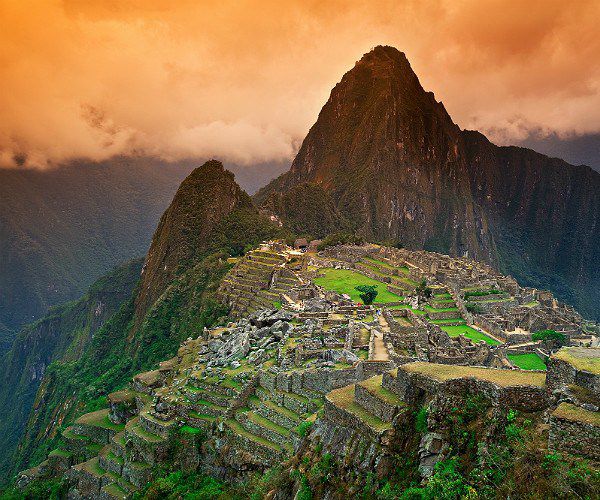
Seeing a Wonder of the World makes for an unforgettable holiday experience – and when better than a special occasion to visit one? From watching the sunrise over the Incan ruins of Machu Picchu to coming face-to-face with some of the world’s most iconic wildlife, these two Latin American icons are true travel highlights. After exploring the colonial treasures of Cusco, the Sacred Valley and, of course, the mighty Machu Picchu, swap to Ecuador to sail the famed Galapagos on a luxury yacht, where everything from giant tortoises and sea lions to marine iguanas and blue-footed boobies awaits as you head on snorkeling trips, hikes, and boat rides.
Stay at the ICEHOTEL
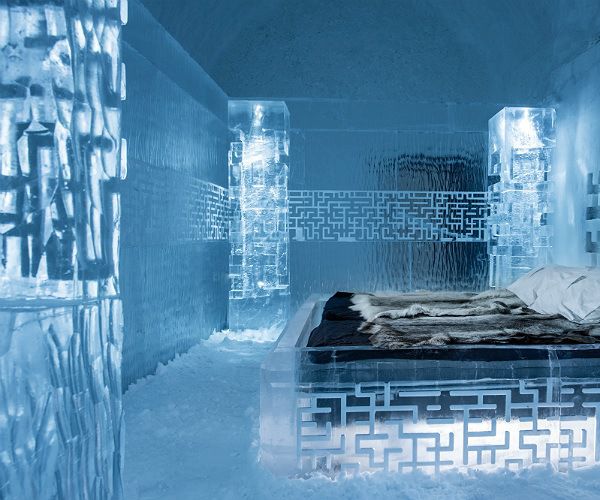
A stay at the world’s first ice-carved hotel is a wonderfully unique way to celebrate a milestone. Shaped by artists from around the world, a bar molded entirely from ice and 12-course ice menus await before you bunk down at -5°C among intricate sculptures and frozen suites, kept warm by reindeer hides and, come morning, a glass of hot lingonberry. And, hidden in the depths of Swedish Lapland, daytimes are jam-packed with winter adventures, from reindeer safaris to husky sledding through snow-silent forests. It’s all topped off by – with luck – the dazzling Northern Lights that sweep above the region for eight months of the year.
Enjoy a luxury Big Five safari

For luxury and wilderness combined, look no further than Tanzania. Setting off from tented lodges – all-inclusive drinks and gourmet meals fuelling you for the thrilling days ahead – you’ll track wildebeest across the Serengeti, ride in safari trucks to spot leopard crouching in trees and watch in awe as elephants stride across the remote bushland. Come back to champagne toasts by the fire in your luxury camp – before perhaps culminating it all on the island idyll of palm-fringed Zanzibar.
Cruise Antarctica on a luxury ship
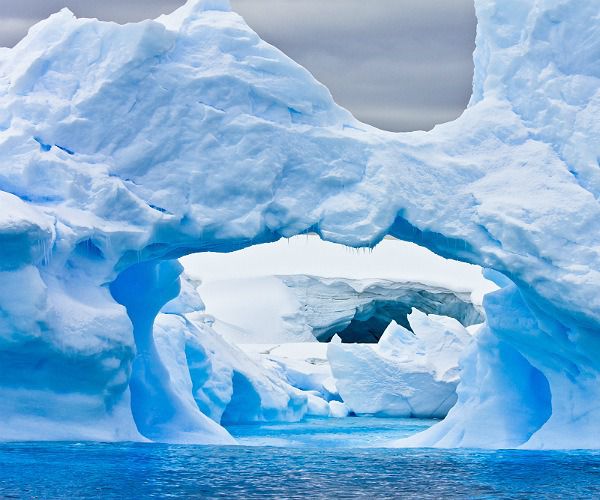
A trip to Antarctica is the very definition of bucket-list – and where better to toast a big celebration than at one of the world’s final frontiers on a luxury cruise? As you explore its ice-covered reaches from Zodiacs and onshore, you’ll spot everything from penguins and breaching whales to giant calving glaciers that break off into the ocean with an almighty crash. It’s all delightfully complemented by fine dining, champagne-paired menus, indulgent afternoon teas, and pianist-accompanied sundowners.
The best day trips from Athens

Being in a capital city, surrounded by millions of people is most certainly fun and exciting as the options of “what to do” and “where to eat” are plentiful. However, that exciting attitude may change if you start to feel stressed out while being on the overcrowded subway or stuck in traffic or waiting for a table to empty in order to sit at your favorite restaurant. So, maybe a day trip is exactly what you need! Athens is a city located in an exceptional geographical location, as sea and mountains surround it so it can really capture the needs of anyone looking to connect with nature. The neighboring towns are small and tucked away in a beautiful landscape, many with important archaeological sites and others combining culture with marvelous outdoor adventures.
Hydra – the romantic getaway
Enjoy a full-day excursion to Hydra, one of the most romantic destinations in Greece, just 2 hours away from Athens. Hydra is indeed a hidden gem, so close to Athens, just waiting to be revealed. This beautiful island offers unspoiled sceneries and a lot of room for exploration. The town of Hydra is built amphitheatrically and is adorned with historic stone mansions, cobblestone streets, Greek traditional taverns, and secluded squares. It is the only island where all automobiles for transportation are banned relying solely on donkeys and water taxis. Once you are there, you may enjoy leisurely strolls along the waterfront and the heart of the town where you will admire a number of monuments, museums, old neighborhoods, and picturesque winding alleys. You will also appreciate its stunning architecture but also enjoy the sensational views across the island to the sea. So board a water-taxi that will get you transferred to a remote beach to enjoy some swimming and then indulge in a delicious seafood meal.
Argolis – the mythical getaway

Grasp the glory of the Mycenaean civilization and discover the precious gems of Nafplio; one of the best-preserved historic towns of the country. You should start from Athens in the early morning and after 1,5-hour drive, you will reach the archaeological site of Mycenae. There, you could enjoy a guided tour of the site, the museum and enjoy the monumental ruins that beautifully blend with the surrounding landscape. Your tour guide will offer interesting information about the history of the Mycenaeans and insights into their way of life. Then, you should head towards the picturesque town of Nafplio and take a leisurely stroll along the cobblestone alleys that will give you the chance to take in the beautiful architecture and to learn about this town’s illustrious past. As a bonus, stop at the spectacular site of Epidaurus to admire the ancient theater and the famous “Asklepieion”.
Delphi – the ancient getaway

A special excursion that will unfold Delphi’s treasures and let you hike its famous ancient and modern paths, including the imposing Corikion Andron Cave. Once you reach the pine-covered foothills of Mount Parnassus, the home of poetry, literature, and learning, you will visit the cave of Corikion Andron. This cave was dedicated to Apollo and his nine muses who lived there and gave artists and thinkers creative inspiration. With your experienced mountain guide, you will hike down the ancient trail connecting the cave to Delphi admiring the imposing landscapes of Parnassus. You will enjoy a stop at the summer camp settlement of “Kroki” where you will quench your thirst at the traditional drinking-water fountain before moving n to hike down the cobbled trail “Skala”, which winds around the town of Delphi offering breathtaking views to the archaeological site Delphi, the Olive grove of Amfissa and the sea.
Nemea – the wine getaway

A fantastic tour for wine lovers! Cross over the impressive Corinth Canal and head south to the Peloponnese peninsula. You will reach Nemea, the most famous wine region of Greece, to start exploring the wines of the popular Greek appellation, famous for its fleshy reds and characterful whites. You could have a wine expert guide who will accompany you to one of the top wine producers of the area for a winery tour, which includes a variety of wine tastings. The wine exploration of Nemea could continue with even more winery visits and wine tastings, if you’re up for it.
Sounio – the sunset getaway

Get ready for a day that will bring you closer to the blue waters of the Aegean Sea; watch the sunset from the Temple of Poseidon, and enjoy an utterly beautiful site close to Athens. You will start from Athens to enjoy the unique experience of watching the sunset from the Temple of Poseidon. The drive along the impressive coastline of Attica is a beautiful experience on its own. The winding road follows the contours of the countless successive little coves and bays, offering amazing views of this dramatic landscape which the ancients associated with Poseidon’s Kingdom.
Author Name: Maria Nikolakaki
Tips for your first safari
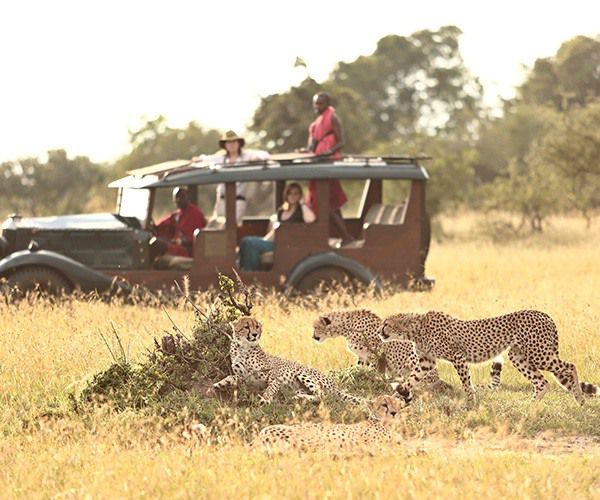
If you’ve booked your first ever safari, or are in the early stages of planning it, the excitement will already be building. You’re probably dreaming of the landscapes, the animals and birds that you’ll see, and the life-affirming experiences you’ll share with your guides and traveling companions. There are plenty of practical considerations during the preparation stage, too. Your destination specialist will likely take care of the majority of these, but you’ll certainly want to make sure that you’ve got travel insurance, checked in with the travel nurse about any vaccinations and malaria tablets that you need, sorted out who is going to feed the cat whilst you’re away, and so on.
I have recalled some of my first safaris to give you the most useful tips to help you prepare. From clothing to guides, these are the things you need to know for your first safari, blogs Laura Burdett-Munns.
Clothes
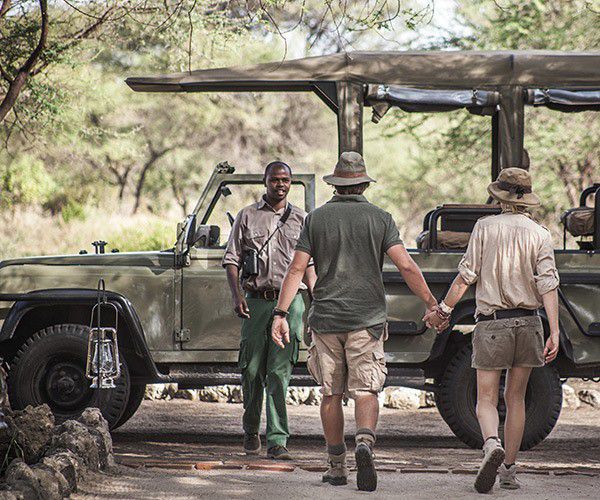
Bring stout shoes, long trousers, and long-sleeved shirts for those chilly nights and bush walks where you might get scratched by thorny plants or bitten by insects. It is recommended you wear neutral colored clothes to blend in with your environment: anything beige, brown, or green will be perfect. This will increase your chance of seeing an animal up close. Don’t forget a hat with a wide brim, either: it can get very hot in the daytime, and the last thing you want is to get burnt or suffer from sunstroke.
Equipment
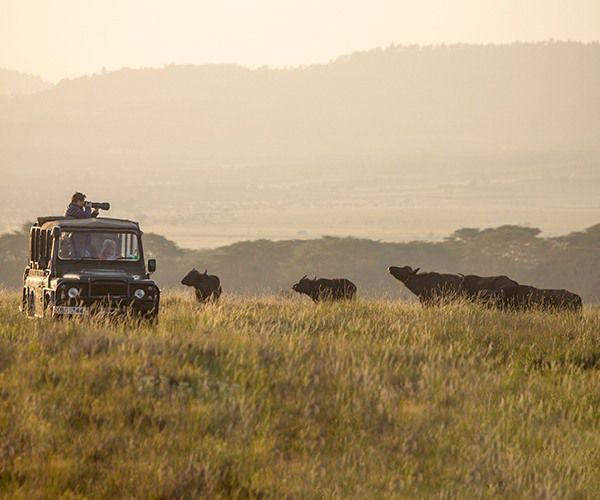
Don’t burden yourself down with equipment, but make sure you know how to use what you have. Guides will generally have professional quality binoculars you can borrow, so your priority will be your camera. A compact camera, smartphone, or small DSLR with an 18-200mm lens will be more than adequate for most people; only pack a tripod, specialist lenses, filters etc. if you take your photography very seriously. Whichever camera you choose, make sure you have a large memory card, plus a spare, the battery and charger, the appropriate plug adapter (NB South Africa uses different sockets to everywhere else!), and a lens cleaning cloth to wipe away dust and smears.
Early starts
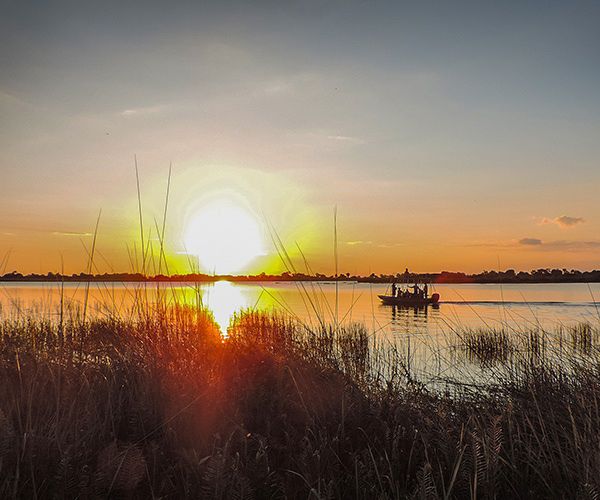
Your days are going to start early! The birds and animals wake at dawn and tend to be most active whilst the day is still cool. This means that you will typically be woken at 5 AM, usually by a lovely member of staff bringing you coffee and biscuits. The early morning is definitely the best time of day for bush walks and boat safaris, and there are good game viewing opportunities during game drives, too. You can compensate for the early starts by having an afternoon siesta when it’s hot, and by going to bed relatively early at night.
Trust your guides
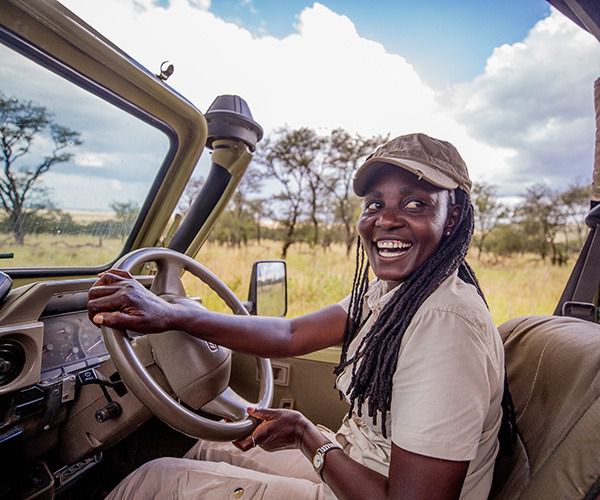
You need to listen and trust your guides. They are the experts. They know what they are doing, and often have been doing it for a decade or more. Listening to your guide is a matter of safety – they may have seen, heard, or smelt something that you haven’t – but they also rely on their experience and intuition to get the most extraordinary sightings for you.
Ask questions
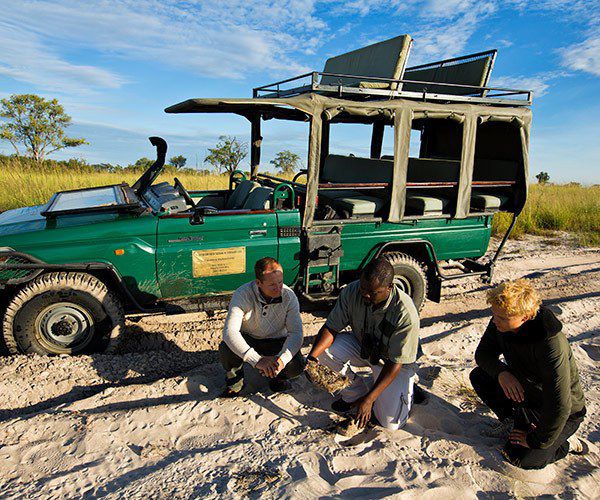
Your safari isn’t just an amazing holiday, it is also an incredible opportunity to learn new things. The more questions you ask, the more you will find out about the different aspects of the extraordinary ecosystems surrounding you. Your guides and trackers have a wealth of knowledge, which often stretches from plant biology to animal behavior, geology to folklore. Draw upon their encyclopedic minds! No question is ever too stupid, and you’ll have a far richer experience if you delve into the fascinating small details your guide can impart.
Head of pilots’ union points to major mistakes with Boeing 737 Max

Boeing’s efforts to save its customers money contributed to the “fatal mistake” of failing to give pilots the crucial information and training they needed to safely fly 737 Max jets, according to the president of a union representing 15,000 American Airlines pilots.
“Unfortunately, as pilots know, improvements in aviation are often written in the blood of the unfortunate victims of airplane accidents,” Captain Daniel F. Carey said in remarks prepared for a hearing before the House aviation subcommittee.
Two new Boeing 737 Max jets crashed within five months – one in Indonesia and the other in Ethiopia – killing 346 people, after investigators say pilots in both crashes were unable to control an automatic anti-stall system that kept pushing the planes’ noses downward based on faulty information from a sensor. Three days after the Ethiopian Airlines crash in March, the Federal Aviation Administration followed its counterparts in other countries and grounded the Boeing 737 Max 8 and Max 9. The jets remain grounded.
Carey, who is president of the Allied Pilots Association, said Boeing’s mistakes were also compounded by company engineers who created the automated feature, known as the Maneuvering Characteristics Augmentation System, or MCAS. The feature was meant to give the planes the same feel to fly as their predecessors, but were not well integrated into the plane, Carey argues.
“The point was to provide Boeing’s customers with a new advanced aircraft while minimizing the training cost associated with a different aircraft certification,” Carey wrote in his planned testimony.
Wednesday’s hearing is part of a broader probe by the House Committee on Transportation and Infrastructure into the causes of the Max tragedies, decisions by Boeing and oversight by the FAA. Members are also scheduled to hear from the industry group Airlines for America, the Association of Flight Attendants-CWA, former FAA administrator Randy Babbitt, and Captain Chesley B. “Sully” Sullenberger III.
Investigators say faulty information from an external sensor on both planes caused the MCAS system to repeatedly misfire, contributing to the crashes. Carey said such a “single-point-of-failure design” meant that “any redundancy to the system, if it failed, was completely dependent on the Captain and First Officer of the aircraft.”
“The huge error of omission is that Boeing failed to disclose the existence of MCAS to the pilot community. The final fatal mistake was, therefore, the absence of robust pilot training in the event that the MCAS failed,” Carey wrote.
Boeing did not immediately respond to questions about Carey’s planned testimony.
Boeing says safety most important factor in 737 MAX’s return

Boeing executives struck an apologetic tone over two deadly crashes of its flagship 737 MAX heading into the start of the Paris Air Show Monday June 18, and insisted that its safe return to action was more important than establishing a speedy timetable.
CEO Dennis Muilenburg told reporters in Paris that Boeing had erred in the way it communicated a faulty cockpit light to both customers and regulators, and said it would take time to win back confidence in the plane’s airworthiness as a result. He also told CNBC that while “steady progress” was being made on the 737’s certification, he would not put a firm date on its return, saying only it would happen “before the end of the year.”
“It is important for us to focus on safety, we will get back up in the air when it is safe, that’s the most important thing here,” Muilenburg said. “We are very confident in the MAX family and the heart of the market where it is located.”
Boeing shares closed at $347.16 each Friday, after falling 0.5% on the session to extend their decline since the March 10 Ethiopian Airlines crash to just under 18%, a move that has loped more than $38 billion from the group’s market value.
Last month, International Air Transport Association director Alexandre de Juniac cautioned that the planemaker’s grounded 737 MAX may not return to full service before the end of the summer, while Muilenburg told an investor conference in New York hat the company was focused on “safely returning the MAX to flight” and stabilizing its production rate at 42 units per month.
The FAA itself has said there would be no near-term clearance for the 737 MAX following meetings with national and international regulators in Forth Worth, Texas, on May 23 that focused on Boeing’s recent overhaul of its MCAS flight software system.
Boeing officially acknowledged that its software system played a role in two recent deadly 737 MAX 8 accidents.
Why choose a cruise for your next holiday?
![]()
The growth in the cruising industry in the past 10 years has been phenomenal. Over 27 million passengers have cruised in 2018, and this is forecast to increase again in 2019 and beyond. As we approach the busiest time for booking holidays, lets explore some of the reasons why this is and why you should consider choosing a cruise for your next holiday.
Value for money
Cruises offer Great Value, with many more inclusions than a standard land based holiday. Cruise fares usually include all food (often for 24 hours a day) and comfortable, even luxurious, accommodations. Entertainment, including Broadway shows and musicals. And exceptional service (an element most cruisers will tell you is the most important aspect for them).

Most of the top luxury cruise lines even include drinks (some even shore excursions) in their fares. It is always wise to consider pricing when choosing a suitable cruise. A lower up front cost doesn’t always mean better value.
I give same advice to all my clients. It is not the cost to board the ship, but how much it costs to leave that is important. Lower up-front costs often mean higher on board costs with lots of extras to be paid for. So a more expensive initial outlay is sometimes actually cheaper than having to pay for extras on board.
See the world
You can visit more than one, and often many destinations on each trip. It is possible to wake up in a new city or country each morning. The best part about this – you only have to unpack once – and after a hard day of exploring, it is great to arrive back to the comfort of your ship.

It makes for a completely stress free way of seeing the world. Cruises can also access some of the less travelled parts of the globe. Even areas which would generally be deemed as inaccessible to most, are now becoming much more accessible via cruising. Alaska, the Galapagos, South Pacific and Antarctica are just a few examples.

You can choose to take a shore excursion in your ports of call, allowing you to experience the local culture, food and places of interest. In most ports, there will be a choice of several different excursions. Many offer different themes or levels of activity, however you don’t have to opt for an organised excursion, you are free to do as you please. Some people use port days to make the most of the facilities on board the ship, as it is usually quieter on board.

On Caribbean Cruises, many cruise lines have their own private island. You can visit here for the day and take part in some of the land and sea based activities they have on offer, or just spend the day soaking up some rays.
Something for everyone
There is a cruise out there to suit everyone. Some are better for couples, some for families. Many have fantastic kids clubs and facilities on board. This allowing the kids to be kept occupied by trained professionals, while the parents can relax, knowing their little ones are being well looked after.

Many cruises are ideal for multi-generational families, and groups of friends. There is so much on offer for everyone that even those friends or family members with very different interests and tastes have the time and space to enjoy their own favourite activities.
Cruises are also a great choice for LGBT and single travellers, with lots of opportunities to meet like minded people and make new friends.
Look out for themed cruises – anything from music, astronomy, marine research, to fasion themed cruises are available.
Facilities on board
Cruise lines can vary drastically, their ships are often different in size and the facilities they offer. Most have a good selection of bars and restaurants, a gym and sports facilities, a spa and wellness centre, swimming pools, onboard activity programmes including cooking classes, art classes, bridge clubs, dancing lessons, even fencing lessons!! Three are giant cinema screens where you can watch movies under the stars on deck, casino’s, some of the larger ships even have ice rinks, dodgems, rock climbing walls, water slides, surfing simulators, zip lines and bungies!!

Many ships have fabulous art collections, and offer guided art tours, on board Oceania’s Marina, there is an incredible collection of fine art, inlcuding 13 original Picasso’s. Many offer enrichment programms, where you can take in guest lectures from famous explorers, artists, actors and musicians.

What other type of holiday offers you the opportunity to see a west end or broadway style show (for free) and be entertained for up to 14 hours per day? Not many.

There really is something for everyone, and no matter how young or old you are, there will be an activity suitable for you. Of course, you have the choice to be as active, or inactive as you want. It is just as easy to find a quiet spot to enjoy reading a book, or try learning a new skill.

Dining choices
Food glorious food! When it comes to dining, there are usually more choices available than days you are cruising. Cruise fares almost always include unlimited food at a buffet restaurant, and the main dining room. There are usually optional dining venues available (some which carry a supplement). Again, it depends on the cruise line, and ship, exactly what is on offer, and included in your cruise fare. The higher end luxury cruises tend to be more inclusive with most dining venues offered free of charge. Some cruise lines even work with acclaimed and celebrity chefs.

Traditional dining times are still offered on many ships, usually with 2 sittings, at around 6pm and 8 or 8.30pm. In this case you have the same table and waiter every night, and choose the table size you would prefer. You may choose to dine with other guests and make new friends for life. Even better – most meals come with an incredible view!

Nowadays more cruise lines are offering flexibility, allowing you to dine at a time to suit you each day. You can also order room service 24/7 and this is included in the cost, on most cruises.

It really is all down to personal preference, and that for me is the most important thing to remember. This is your holiday, and you should be free to enjoy it however and with whoever you choose. Cruising allows you to do this like no other type of holiday, but it is important to choose wisely.
Cruising is also a great way to meet and make new friends, and experience different cultures. There are often 20+ nationalities on board (not even including the staff who also come from all over the world).
Whether a seasoned cruiser, or new to cruise, I would be delighted to help you choose the correct cruise to suit your needs. You might even end up hooked, like me!
By Kim Robertson from www.yourwaytoluxury.com
The best courses for a ladies’ golf trip in Scotland

Although it has a reputation for being a man’s sport, golf has also been a great sport for women. Ladies have been playing golf since it was popularized 500 years ago. In fact, Mary Queen of Scots is considered the mother of golf, and played often to release the stress of trying to claim her throne. She was once suspected of the murder of her husband because she went to play a round too soon after his untimely death.
Of course, some courses still forbid women to play, and there are some where women are allowed but may not feel totally comfortable. As an expert in planning the perfect golf adventure for men and women alike, I’ve compiled a list of the best courses for a luxury ladies’ golf getaway in Scotland.
Cruden Bay Golf Club
Designed by Old Tom Morris of St. Andrews fame, Cruden Bay’s Championship Course is a classic Scottish links that does not disappoint. Thanks to its remote location, Cruden Bay is often uncrowded, allowing players of all levels to play at their own pace. The green (forward) tees will give you about 5,300 yards — while still providing challenging bunkers and gorgeous sea views. The nearby village is also home to an extremely charming hotel, the Kilmarnock Arms, where Bram Stoker was inspired to write Dracula, thanks to a full view of the New Slains Castle.
Gleneagles
If your ladies’ weekend goal includes golf, a spa, and a luxurious hotel, look no further than
Gleneagles. Known as “the Riviera of the Highlands”, this country estate has been a getaway for the well-heeled since 1924. They’re also hosting the 2019 Solheim Cup, which will bring added attention to the course. The PGA Centenary Course is a beautiful, challenging course, as well as a former Ryder Cup host, whose red (forward) tees offer just over 5,300 yards of play. Gleneagles offers three championship courses overall, plus two renowned 19th holes, as well as the aforementioned spa to make for a perfect getaway for the golf-loving ladies in your life.

Royal Dornoch Golf Club
A must-play natural links course in the Scottish Highlands, the Championship Course at Royal Dornoch has been known for its beauty and difficulty of play since 1616. The design of the current course is attributed to Old Tom Morris, which adds to its appeal as a traditional Scottish links course. Royal Dornoch also has a history of providing ample opportunities for women to play; the sister Struie Course was originally a 12-hole course meant just for ladies.The village of Royal Dornoch is another remote yet charming seaside town that provides a nice escape from city life. For the whisky lovers in your group, Glenmorangie Distillery is a mere four miles away, too.

Kingsbarns Golf Links
A short seven miles from St. Andrews, Kingsbarns is a memorable links course stretching along nearly two miles of North Sea coastline. The course hosted the 2017 Ricoh Women’s British Open, and provides a stunning variety regardless of your group’s overall abilities. Unlike some of the top Scottish courses, Kingsbarns doesn’t have a handicap restriction, and that plus the ease of play from the forward tees allows less experienced players a chance to play a true links course. Also, St. Andrews provides an excellent place to stay nearby for shopping, dining and luxury accommodations.

Castle Stuart Golf Links
The picturesque Castle Stuart, which gives the course its name, overlooks this Highlands links course, and the resort includes a small luxury hotel and spa. Other notable landmarks such as the Kessock Bridge, Chanonry Lighthouse, and Fort George are all visible from the seaside holes, making this the sort of course where you get your sightseeing in while teeing off. The course itself is much newer than most of the links courses in Scotland, having opened in 2009, but golf lovers will note that the course is a welcome return to golf as it was originally intended: leisurely and surrounded by nature.

By Ravi Coutinho from https://worldwidegolfadventures.com/
Don’t let travel document problems ground your next vacation
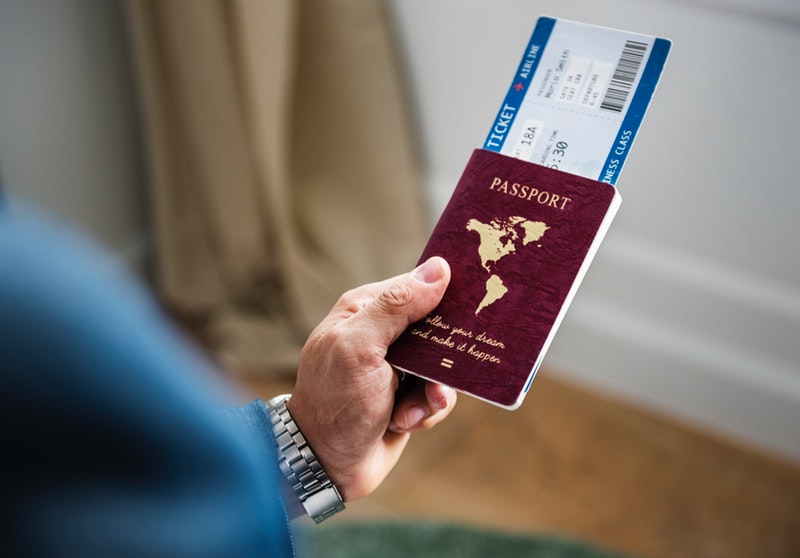
If you think your international travel documents for your next trip abroad are ship-shape, you might want to talk to Chrysoula Chrysogelou.
Chrysogelou, a hotel manager from Greece, was flying from Athens to Chicago recently when a Lufthansa agent told her – wrongly, as it turned out – that her permit from the U.S. Customs and Border Protection’s visa waiver program (ESTA) was invalid.
Because it was going to expire before she returned home, she had to pay $522 for an earlier flight. She hoped Lufthansa might refund the money once it realized its error, but it refused.
Travel document requirements can be complicated, but as Chrysogelou found out the hard way, they’ve become even trickier lately.
Passengers say that on top of having to obtain the proper visas for their destinations, they also now must meet an airline’s requirements, which can be even stricter. And even when airline staffers know the rules, those rules can be unevenly enforced.
So, unfortunately, it’s on you to make sure you dot every “i” and cross every “t” before you board your plane to Europe this summer.
These days, you may have to jump through extra hoops at your airline’s check-in desk before you even make it to passport control.
Visa waivers may not be enough
If you’re traveling internationally, you might need a visa, which is an endorsement on your passport indicating that you may enter a country. Americans don’t need visas to enter 116 countries – including 26 in Europe – for short-term tourism, business or layovers on the way to a non-treaty country. However, some popular destinations such as China require U.S. citizens to obtain visas.
In Chrysogelou’s case, she qualified for a visa waiver for her trip to the United States. And while the waiver was valid when she began her trip, the German-based Lufthansa imposes an additional requirement: Passengers must have valid documents for the “entire duration” of their stay. (After I asked Lufthansa about her case, it rescheduled her flights to her original dates.)
In other words, you need to know how long you can remain in your destination country without a visa. If your trip exceeds that period – typically 90 days for U.S. passport holders visiting European countries on business or leisure trips – you need to obtain a visa through the embassy of the country where you will spend the bulk of your visit.
Paperwork confusion is common among airline staffers
Chrysogelou isn’t the only traveler with a tale of woe involving travel documentation and misinformed airline agents.
Atif Shabbirdin, a building manager from Boxhill, England, says his wife, who resides in Spain, ran into trouble when she tried to fly EasyJet from Malaga, Spain, to London.
“An EasyJet representative wrongfully stated that because she had a Moroccan passport, she needed a visa to join me in the U.K.,” he says. “Prior to her travel, we had checked with the Border Control telephone helpline and were told there were no visa requirements.”
Shabbirdin’s wife showed the agent her European Union-issued Spanish residence card, but it didn’t help.
“EasyJet would not budge until my advocacy team showed it chapter and verse of the entry requirements,” he recalls. “It then apologized and refunded the unused airline ticket. The airline also covered her expenses and the ticket she had to purchase.”
There’s also the case of Anita Tolani, an attorney from Bethesda, Maryland, whose Bahamas vacation was imperiled when American Airlines wouldn’t let a member of her family board their flight from Washington, D.C., to Nassau.
“The gate agent would not allow my daughter to travel because her passport expired in February,” she says. “The agent insisted that the passport had to be valid for six months after the Dec. 20 date of return.” (As noted above, that is a recommendation from the State Department, not a hard-and-fast requirement, as the airline employee insisted.)
The State Department information page regarding travel to the Bahamas is clear: U.S. passports, it says, “must be valid at time of entry.” American has a separate policy requiring all passports to be valid for at least six months past the date of travel.
I reached out to American about Tolani’s case, and it issued two ticket vouchers, plus two more $200 vouchers for her “trouble.”
Know the rules – all of them
Experienced travelers know that they need to know the rules before they travel. Get them from a reliable source – namely, a government agency. Then bookmark the relevant document on your smartphone and, to be extra safe, bring a printout, too.
“The only sure way to know if you have the right visa is to visit the official government website for the destination country and check the requirements for your passport,” says Eric Wychopen, a frequent traveler and blogger based in Maastricht, Netherlands. “Going by the experience of other travelers or even relying on third-party visa providers is not a guarantee that your entry documentation is in order.”
Bottom line: Even if you think you have the right documents for your summer trip, you may also bump up against airline policies that might ground you. Check with your airline, cruise line or travel agent if you have any doubts.
Where to find reliable information about travel documents
To ensure you can make your international trip smoothly, you’ll want to consult these sources. Make printouts of the appropriate pages and take them with you.
Check official sources
The State Department lists the most current passport and visa requirements for U.S. citizens. You may also want to check with the embassy of the country you’re visiting. For example, if you’re headed to France, you can find out about its travel document requirements through its embassy in Washington.
Consult Timatic
The most reliable non-government source of travel documents information is Timatic, which you can access through the International Air Transport Association’s Travel Centre. Tom Harriman, an attorney based in Washington, D.C., says Timatic information carries a lot of weight with airlines when there’s a question about your travel documents. “You hand the gate agent the Timatic printout,” he says. “Game, set, match!”
Review your airline’s website
Remember, the airline’s requirements can differ from the official government requirements. For example, as Tolani found out, if you want to board an international flight on American Airlines, your passport must be valid “for at least six months” after the date you enter a foreign country – even if the State Department’s information page says otherwise. For help getting started, do a Google search for “international travel documents” or “required travel documents” and the name of your airline.
By Christopher Elliott, founder of Elliott Advocacy



